Australian
and international
exploratory
performance and
media arts
<img src="http://www.realtime.org.au/wp-content/uploads/art/3/361_ndalianis_eyes.jpg" alt="David Lawrey & Jaki Middleton,
The Sound Before You Make It (2005),
kinetic installation with strobe lighting and audio”>
David Lawrey & Jaki Middleton,
The Sound Before You Make It (2005),
kinetic installation with strobe lighting and audio
courtesy of the artists
David Lawrey & Jaki Middleton,
The Sound Before You Make It (2005),
kinetic installation with strobe lighting and audio
DEVELOPED FROM THE EXHIBITION HELD AT THE HAYWARD GALLERY, LONDON (2004-5), EYES, LIES & ILLUSIONS AT THE AUSTRALIAN CENTRE FOR THE MOVING IMAGE CONTAINS MORE THAN 500 BOOKS, PRINTS, OPTICAL INSTRUMENTS AND TECHNOLOGICAL WONDERS THAT ARE DRAWN FROM THE WERNER NEKES COLLECTION (MULHEIM-AM-RUHR, GERMANY).
This extraordinary collection began in the mid-1960s when Nekes, a German experimental filmmaker and professor in film studies, started collecting examples of optical phenomena as teaching aids that highlighted pre-cinematic history. The objects, however, developed a mind of their own and grew beyond their pre-cinematic agenda into an encyclopaedic collection that now comprises approximately 25,000 devices devoted to the history of optical technologies.
If the Nekes collection can be understood as a contemporary wunderkammer that encases a micro-history of pre-20th century visual media technologies, then Eyes, Lies & Illusion might be seen as a micro-micro-history. Cameras obscura, magic lanterns, praxinoscopes, peep-boxes, daguerreotypes, kinetoscopes, panoramas and anamorphic lenses populate the appropriately darkened lower bowels of the ACMI building at Federation Square. The most impressive feature of this exhibition is that it represents a pansemiotic logic: each object is endowed with multiple layers of signification that speak of the past, the present and the present’s relationship to the past.
The exhibition is divided into seven thematic sections. Shadowplay, Tricks of the Light, Riddles of Perspective, Enhancing the Eye, Deceiving the Mind, Persistence of Vision and Moving in Time all introduce the audience to a gamut of spectacles, wonders of science and the technologies that create them: puppets, shadow theatres and magic lanterns manipulate light and dark to produce wonders that delight; prisms, lenses, mirrors and kaleidoscopes distort and alter light to reveal its mysterious properties; truly enchanting dioramas, panoramas, perspective boxes and a walk-in, distorting Ames Room all make concrete the mathematical principles of perspective; cameras obscura, scientific studies on anatomy, microscopy and astronomy, and examples of early photography reveal the way optics and technological innovation made visible the previously invisible; anamorphic images, visual cryptograms and optical illusions show how the human eye can succumb to artificially produced tricks of the eye; the wondrous motions of phenakistoscopes, zoetropes and praxinoscopes appear to magically create animated worlds; and pioneering experiments in photography and the cinema capture indexical reality opening the way to a new generation of optical illusions.
Teasing its audience with a rich, engaging and entertaining history of technological inventions that enhance and deceive human vision and perception, Eyes, Lies and Illusions typifies the active relations that many of these technologies command of their viewer-participant. The exhibition demonstrates the continuity of interest that has persisted in using media, in particular entertainment media, to push the boundaries of technology and vision, art and science through centuries. A pair of Florentine works painted on the natural stone known as pietre paesina (1620) depicts battle scenes and crumbling castles. Here, nature and art collide. In places, the natural patterns created by the stone’s surface portray smoke and crumbling castle walls; in other places, the artist’s hand takes over to depict the same subject matter. The eye is deceived. Where does nature end and human artifice take over? Perspective boxes and dioramas invite the participant to peep into their initially concealed spaces in order to discover alternate, virtual landscapes, theatrical performances and seascapes. Transparent pictures and Chinese shadow theatres transform their dark, two dimensional spaces into brightly lit, marvellous three-dimensional worlds. And in one of the 12 contemporary works, The Sound Before you Make It (2005), a kinetic installation with strobe lighting by the Australian artists David Lawrey and Jaki Middleton, the phenakistoscope’s reliance on the phenomenon of persistence of vision is given a new context as amused viewers watch small and static Michael Jackson figurines succumb to motion as the merry-go-round disc they stand on swings around and around to the rhythm of “Thriller.” The arrangement of all these objects serves to build visual (and audio) bridges that emphasize the playfulness of nature through the associative powers of sight.
Significantly, the experience of this exhibition reveals how no media are ever divorced from history. The camera obscura, for example, reveals its connections with the later invention of photography. The eerie 3D stereoscopic image of the filmmaker Lumiere reveals its connections to the spatially layered but illustrated 3D spaces of the dioramas. Marey’s chronoscope experiments expose themselves as predecessors of the digital animations used in current film effects—a fact also stressed in Carsten Höller’s 1998 work, Punkterfilm, which similarly maps a geometric depiction of movement. And perspective instruments, treatises and the objects that reflected its laws—dioramas, panoramas, and perspective boxes—reveal how they have found a new form of expression in the boxed screens that contain the virtual architecture of computer game spaces. But these objects are so much more than examples that highlight the path that eventually led to the diverse media of our own times. Almost every technological apparatus or depiction of wondrous media in action within this show shines independently of the role it serves as predecessor to a later media format.
The magic lantern is a case in point: walking through the show, the captivating properties of the optical devices have the capacity to ensnare the viewer with their mesmerising powers. It’s easy to forget the complex historical and cultural contexts that nurtured the production of these technologies and the modes of perception they evoked. As the concise and informative exhibition labels explain, and as is made even clearer in the excellent exhibition catalogue, the initial popularity of the magic lantern as visual entertainment has its origins in the 17th century. Athanasius Kircher, baroque scholar and scientist of encyclopedic proportions and the individual often (incorrectly) credited with the magic lantern’s invention, discusses its function and outlines his observations and experiments in light and shadow in his book Ars Magna Lucis et Umbrae of 1646 and in Physiologia Kircheriana Experimentalis of 1680, which is represented in the exhibition. Through their entertaining properties, these optical devices expressed the ways in which contemporary ‘science’ had altered perceptions of the universe.
The examples of magic lanterns range from simple, hand carved wooden boxes with lenses, to highly crafted metallic exteriors that depict the Eiffel Tower—all works of art in their own right. The sensory impact of the exterior designs further extends to the capabilities of the interior mechanics: a projection of H McAllister’s magic lantern slide of a dancing skeleton (c.1880), which was filmed by Nekes as part of his Media Magica film series (snippets of which are projected throughout the exhibition and successfully visualise many of the technologies in motion), drives home the fantastic and entertaining nature of the objects. Yet, the magical properties of these boxes are found not only in their well-crafted exteriors and the illusionist possibilities that this technology is capable of, but the micro-historical role they served. The various lithographs, prints and books from the 17th, 18th and 19th centuries accentuate this by providing snippets from time past: the image of a magic lantern projecting an image of a demon, for example, is from Gulielmo Jacobo ’s Gravesande’s two-volume book, Physices Elementa Mathematica (1748). As one of the earliest and most influential followers of Newtonian philosophy in Europe, ’s Gravesande’s image of the demon projection, and the accompanying image that reveals the interior mechanics of the magic lantern, visualised the theory of optics and light. A fantastic subject matter served a rational and scientific purpose that speaks of the arrival of the era of Enlightenment. Throughout its history, the magic lantern both enchanted and reflexively drew attention to the more rational function that these public spectacles served as scientific explorations of modes of perception, and of how the human eye is capable of being deceived through technological means. The books and prints in the collection play a significant role in highlighting the context of display; the magic lanterns the method and rationale of reception.
One of the most dramatic examples of this is the display of the frontispiece of Étienne-Gaspard Robert’s Mémoires Récréatives Scientifiques (1831), which depicts one of his famous phantasmagoria lantern projections. Better known as Robertson, he was a Belgian inventor, physicist and student of optics who improved the technology of the magic lantern, including its capacity to enlarge and decrease images. Robertson performed his most infamous show in Paris in an abandoned chapel surrounded by tombs. Crowds flocked to the dimly lit graveyard to experience (initially concealed) magic lantern effects of flying skulls and ghoulish apparitions against the backdrop of creepy lighting and sound effects. While it isn’t clear whether the frontispiece depicts this performance, the participants in the event, nevertheless, respond in similar ways by fainting, screaming and running away from the horrors that appear before them. Yet, despite the centrality of illusion and the theatrical emphasis on the fantastic, Robertson’s intentions were also scientifically motivated. His application of the magic lantern reflected Enlightenment concerns with scientific rationalism; reason and a scientific approach to the world could, it was believed, arm the individual with answers to the most fantastic and irrational of problems. Exposing his methods after the ghostly spectacle, Robertson’s aim was to arm the audience with scientific reason by showing them the technological and scientific means by which he conjured his illusions: the fantastic was a deception controlled by technological means.
For these magicians and popular scientists, there was nothing science and technology could not explain or achieve. But as commentators like Octave Mannoni, who contributes one of the chapters in the exhibition catalogue, has explained, and as those who experience this exhibition clearly understand, having insight into the means of the illusion’s production—its trick—exposed and explained through rational means and scientific process doesn’t make that illusion any less astounding. If only to experience this state of bizarre ambivalence, it is well worth visiting this fascinating and, in many respects, ground-breaking, exhibition.
Eyes, Lies & Illusions, Australian Centre for the Moving Image, Nov 2, 2006-Feb 11, 2007
RealTime issue #77 Feb-March 2007 pg. 21
© Angela Ndalianis; for permission to reproduce apply to realtime@realtimearts.net
THE IMAGE, FRAMED AND HUNG TO CATCH THE EYE AS ONE FIRST ENTERS THE GALLERY, IS A SUITABLY CHARACTERISTIC ONE: DYNAMIC IN COMPOSITION AND TONE, WITH AN INKY FLUIDITY TO ITS LINE, IT SEEMS AT ONCE BOTH ORGANIC AND FUTURISTIC, NOT TO MENTION KIND OF CUTE. IN IT, ASTRO BOY, THAT ICONIC AND SPRIGHTLY BOY CHILD ROBOT WHO FOR DECADES NOW HAS SERVED AS THE AVATAR OF JAPANESE ANIME AND MANGA IN THE WEST, IS FIGHTING A GOOFY LOOKING HUMAN ADULT, WHOSE EXPRESSION OF BEWILDERED ASTONISHMENT CAN BE GLIMPSED AS HIS SINEWY BODY SOMERSAULTS BACKWARDS THROUGH THE AIR, SOUNDLY PUMMELED AND CLEARLY BEATEN.
<img src="http://www.realtime.org.au/wp-content/uploads/art/3/374_clayfield_tezuka_black.jpg" alt="Tezuka, Black Jack, cover from Black Jack, 1974,
Weekly Shonen Champion, published by Akita Shoten”>
Tezuka, Black Jack, cover from Black Jack, 1974,
Weekly Shonen Champion, published by Akita Shoten
©Tezuka Productions
Tezuka, Black Jack, cover from Black Jack, 1974,
Weekly Shonen Champion, published by Akita Shoten
The exhibition in which this image appears, Tezuka: The Marvel of Manga, is full of such visually striking images. Developed by and for the National Gallery of Victoria in collaboration with guest curator Philip Brophy, and touring to both the Art Gallery of New South Wales, Sydney, and the Asian Art Museum, San Francisco, in 2007, the exhibition marks the first Western retrospective of the work of pioneering manga artist and innovator Osamu Tezuka, creator not only of Astro Boy and Kimba the White Lion (aka Jungle Emperor), but of over 700 other manga titles. Not all of these are represented in the exhibition, of course, but those that are (about sixteen titles) are not only representative of the remarkable breadth and depth of Tezuka’s oeuvre—not to mention its quasi-philosophical richness and inherent humanistic worldview—but also clearly establish him as one of the finest graphic artists of the post-war period, artist, entertainer or otherwise.
For the Western viewer, the iconic figure of Astro Boy serves as a convenient entry point into the world of both manga and Tezuka. I am no exception. Like many of my generation, my only previous connection to Tezuka was watching Astro Boy on television back when I was a little kid. His spiky black hair and his rocket booster boots are instantly recognisable but my interest in this sucker punch of an image—and in the exhibition waiting beyond it—has less to do with my childhood memories of serialised early morning cartoons than it does with the image’s graphic power, which is like a black-and-white slap in the face.
Tezuka’s work pivots on a series of dichotomies. The most obvious of these is the not-quite-absolute split between his manga for children and his gekiga for adults, embodied in the exhibition space itself by the colour-coded division between green walls (children’s manga) and blue (adults’ gekiga). However, this is by no means the only or the most interesting dichotomy. There is also the divide—a certain graphic tension—between abstraction and figuration, which often manifests as a struggle between page layout and panel content, or, within the panels themselves, between background and foreground (Tezuka’s backgrounds are like Futurist Florence Broadhurst wallpapers, particularly in a manga like Astro Boy).
There’s also a tension between modes—one might even say ‘schools’—of visual representation; a tension which cuts across all the manga and gekiga appearing in the exhibition. At times, Tezuka’s work seems to strive towards a kind of no-nonsense (if certainly heightened) realism; at others, it embraces no-holds-barred abstraction, Impressionism, or my personal favourite, Surrealism.
There are panels (and whole pages) in some of Tezuka’s darker gekiga work, particularly Bomba and Eulogy for Kirihito, which shock with their surrealist imagery. In a page from the latter, to illustrate Kirihito’s mental and physical torment as he transforms into a hybrid creature—half-dog, half-man—Tezuka gives us a series of disparate, terrible images, motivated not by any narrative or diegetic causality, but by a kind of emphatic, affective causality. The image of a primitive, almost totem- or sculpture-like being, lying on its back against a solid black background screaming, is genuinely terrifying (indeed, it was one of a few images that, for its very strangeness and uniqueness within the context of the exhibition, I just had to go back and see for a second time before I left). Other panels on the same page show a solid black form in the shape of an explosion and the turbulent surface of a pond during a downpour.
In another image from Kirihito a doctor, in a hospital somewhere, comes to a shocking realisation about something or other. Presently, his glasses begin to levitate, floating away from his face, which fades away. The floating spectacles instantly recall the floating bowler hats of Hans Richter. Rising against an empty white background, the spectacle lenses suddenly crack. Blood pours out into the air from invisible eye sockets. And then we’re back in the hospital again, in reality, ready to get on with the story.
But this page appears in a frame, behind glass: there’s no story to get on with. The images are abstracted, fragmented, devoid (even robbed) of their narrative context. Continually, we are told—by the wall panels, by the room book, by the small army of tour guides who lurk behind corners waiting to jump out and inform you—that Tezuka’s manga is concerned, first and foremost, with the telling of a story. But in the context of the gallery space, where comic books are hung as opposed to held, fingered, dog-eared and read, manga-stories become—(gasp!)—graphic art and, as such, at least comparatively, storyless.
And so as I leave this visually exhilarating exhibition, feeling genuinely excited about all that I have seen, I am hit all of a sudden by a feeling that I’ve missed something. I begin to wonder if I really know any more about manga than before. I wonder if I know less. I realise I want to turn the page and to find out what happens to Astro. The visual dynamism of his movements seems less important to me now. A gallery wall is not a comic book. I want to know what happens next.
Tezuka, the Marvel of Manga, curator Philip Brophy, National Gallery of Victoria, Nov 3-Jan 28; Art Gallery of New South Wales, Feb 23-April 29; Asian Art Museum, San Francisco, June 2-Sept 9
RealTime issue #77 Feb-March 2007 pg. 22
© Matthew Clayfield; for permission to reproduce apply to realtime@realtimearts.net
THE DIVIDE BETWEEN THE MARKET SECTION OF THE AUSTRALIAN INTERNATIONAL DOCUMENTARY CONFERENCE WHERE PRODUCERS PITCH PROJECTS, AND THE CONFERENCE SECTION THAT FOCUSES ON THE CRAFT OF MAKING THE DOCUMENTARY IS BECOMING INCREASINGLY CONTENTIOUS. THE NEW CONFERENCE DIRECTOR HAS EVEN ENSURED THAT THE TWO STRANDS NOW OCCUR IN SEPARATE SPACES.

The Socialist, The Architect and the Twisted Tower
For the last few years the award-winning Adelaide filmmaker Heather Croall (now Festival Director, Sheffield Docfest, UK) ran the event. She brought to AIDC an internationalism, a slickness and an ongoing commitment to maintaining the craft section of the conference. The new director Joost den Hartog comes from the market side of documentary events. He has organised markets at, among others, Amsterdam’s IDFA, Toronto’s Hot Docs and our very own AIDC. His appointment represents a shift in dynamics for AIDC.
English is not den Hartog’s first language and he has the diplomatic considered speech patterns of a person who is not a native speaker. He is fast to assure me that non-market sections of the conference are still important. “The marketplace is an important part of the conference but that is not the flagship or the main focus. The main focus this year, because we are celebrating AIDC’s 20th anniversary, is on motivation and inspiration and trying to find answers for questions like, ‘What is the purpose of documentary for society?’.”
The ‘conference’ sessions from the programme profiled on the AIDC website are almost all market related and aimed at producers. These sessions are the traditional territory of directors, writers, editors and cinematographers. Documentary directors and writers may mutter under their breath about keeping the craft sessions but den Hartog is actually catering to his market by doing this. Documentary filmmakers have voted with their feet at previous conferences, turning out in droves to anything about potential financial resources. In a sense the ‘conference’ sessions for the directors et al had almost become sideshow to keep them entertained whilst their producers ran around like mad chooks cornering funders and TV execs.
The final session is where the large question “Can Documentaries Change the World?” will be posed. Ross Kauffman, one half of the directorial team of Born Into Brothels: Calcutta’s Red Light Kids (2004), will talk with Variety film critic Richard Kuipers to try to find an answer. The question implies functionality as fundamental for the documentary form. It turns out den Hartog does indeed like documentary to have a function, “Call me a hippy or naive, but I think documentary is a very powerful way to raise awareness and to actually mobilise behavioural change and establish social change in society. I am very convinced of that. And I think that there are plenty of examples of recent films that have been able to do that…The most obviously example is An Inconvenient Truth. Now even John Howard thinks that there is something like global warming going on. It is quite an achievement for a filmmaker to get to John Howard.”
Unfortunately it looks likely that Participant Productions’ Diane Weyermann will be unable to attend the conference, because she’ll be busy glamming up for the Oscars where An Inconvenient Truth (2006) is nominated. However Participant Productions is a company well worth watching. Started by the eBay billionaire Jeff Skoll, it aims to fund films that have a social change agenda and turn them into films that will have broad appeal. The company’s tagline is, ‘Lights, camera…social action!’
One of the interesting side effects of the market people taking over conferences is that they have created a space in which filmmakers might start thinking creatively about the marketplace. Joost says, “On the Monday of the conference there are two sessions designed to explore an alternative marketplace by looking at the example of the internet and starting to look at relationships between various platforms. It will also look at other potential financiers like NGOs. DocAgora is an international initiative which had its first gathering in Amsterdam.” There are DocAgora sessions planned for a number of conferences around the world. (DocAgora describes itself as “a virtual webplex” for documentary: “an open space to consider new forms, new platforms and new ways of financing creative, authored and socially engaged documentary content. www.docagora.org). Joost continues, “A report will be written of all the sessions and eventually it will have to result in an alternative marketplace that can exist next to the traditional broadcast model.”
Whilst on the subject of commissioning editors, an embarrassing moment occurred last conference when the search for a commissioning editor during a pitching session resulted in a speakerphone admission that she was at the beach. It’s a worrying notion that buyers might see AIDC as a beachside break. Joost says, “We screen all buyers on their willingness to work with Australians and Australian content. And the reason why they come is that they are interested in Australian content or have a willingness to work with Australian producers. We do a follow-up every year after the conference to see what kind of deals are made. Most of them go home with two or three presales and a bunch of contracts and projects in development.”
A large contingent from Asia will be attending AIDC this year. Joost says “We have quite a big involvement from Discovery Asia and [they] will announce a scheme which is new. They have given their Australian office a fund to commission Australian content. It will be spread over two years for the Australian independent sector.”
When asked about what he thinks are the current crises in documentary den Hartog mentioned the obvious, not enough funding, but also felt, “the broadcasters are in a more competitive market these days and they want to brand their channels. That has consequences for independent producers and on the type of content that [the broadcasters] acquire.” The issue of branding will be covered at the conference at Rudy Buttignol’s session, called “It’s the Flow Not the Show.” (Buttingol is a leading Canadian network commissioner and programmer). It promises to be an interesting session considering the traditional notion that documentary is about ‘program strands’ and that individual 50 minute works are fast giving way to reality style series in Australia.
Australian International Documentary Conference, Adelaide, Feb 23-26, 2007, www.aidc.com.au
RealTime issue #77 Feb-March 2007 pg. 20
© Catherine Gough-Brady; for permission to reproduce apply to realtime@realtimearts.net
SUPER 8 HAS HAD A RESURGENCE OF LATE WITH SYN CITY AT THE ACP AS WELL AS SUPER 8 SCREENINGS AT THE CHAUVEL CINEMA. BOTH SHOWS WERE PART OF D/LUX/MEDIA/ARTS’ 25TH ANNIVERSARY THAT ALSO SAW THE LAUNCHING OF D/ARCHIVE.
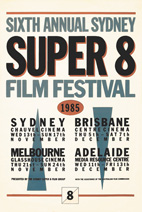
Posters, Sydney Super 8 Film Group
Courtesy D/Lux/Media/Arts
Posters, Sydney Super 8 Film Group
As part of the archive project I interviewed Kate Richards, who set up the first two Super 8 festivals, and Mark Titmarsh, who was instrumental in the formation of the Sydney Super 8 Film Group later to become Sydney Intermedia Network and finally d/Lux/Media/Arts.
Kate, you initiated the first Super 8 film festival with Deb Collins. Your background was a distinctively Sydney 80s mixture of politics, squats and French cultural theory?
KR We both began shooting Super 8 while still in high school, and were very political young people and strong feminists. In 1980, when we established the first Super 8 film festival we were living in the Surrey Street squats…Our imperative was just the politics of getting this stuff up on screen. Deb approached the Sydney Filmmakers Co-op to put the work on. She talked them through their initial response of, ‘Oh Super 8, that is not a valid format.’ They were media makers, content and documentary orientated, and artisanal based. What we represented were the new wave of the tertiary-educated, French theory driven students from UTS. Further down the track I could see that without a strong studio practice the whole thing falls over.
How did the first festival go?
KR It was an unbelievable success. We made a little poster and we photocopied it and just stuck it around in cafés and on posts and people had to mail their work in. We got a huge amount of films and we showed them all. The program was very long and we packed out the Co-op the whole weekend. The Co-op were astounded as they had a lot of trouble getting bums on seats. I think the festivals captured a moment when a whole lot of new forms of aesthetics and signification were starting to bubble away—classic post modernity before the term was being used in Sydney—films such as Stephen Harrop’s Square Bashing, with found footage re-configured, and very well cut.
You then moved to England and connected with the Bristol scene. The festival needed new patronage.
KR Yes, luckily they all appeared in that Brisbane wave. There was a big influx in the late 70s: musicians, artists and social workers. They were really quite smart, sophisticated and articulate, coming out of such a repressive regime as Bjelke Peterson’s. I think it was a natural progression that this new group would take over the next festival.
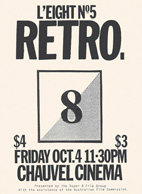
Posters, Sydney Super 8 Film Group
Courtesy D/Lux/Media/Arts
Posters, Sydney Super 8 Film Group
MT My earliest involvement with Super 8 in Sydney was contributing two films to the second festival in 1981. After that festival Ross Gibson, Lindy Lee, Deirdre Beck, Janet Burchill and myself got together and we called ourselves the Super 8 Collective.
After successfully applying for a grant from the Australian Film Commission we held the 3rd Sydney Super 8 Film Festival in November 1982 at the Chauvel Cinema in Paddington. The cinema had a capacity of 300 hundred seats. It was full every night and was like that for every annual festival for most of the 80s. I don’t think there were many sophisticated debates around the selection process. We were a test audience, a colosseum forum that voted thumbs up or down.
There was a scene there that grew in sophistication as long as the technology was viable. Over that period a new core of people began to develop with Gary Warner, Virginia Hilyard, Michael Hutak, Catherine Lowing, Andrew Frost and myself. We also did a whole series of Film Readers as well as the festival catalogues and posters, all of which demonstrated a post-do-it-yourself-new-wave aesthetic.
What were some of the political and aesthetic considerations of the filmmakers involved?
MT Andrew Frost, Michael Hutak, Gary Warner, Stephen Harrop and myself all eventually formed Metaphysical TV. We all made films about our relationship with the television screen. We used Super 8 to shoot directly off the screen, reconstructing the material into some personal or perverse work. It all fell into current discussions of post-modern quotation and appropriation. Catherine Lowing was working with a similar sensibility but without the direct relation to television; she was into subcultures, rockabilly, video clip…and dance cultures. Virginia Hilyard was more into a poetics of cinema; she did experiments with expanded live performances. Her work was close to neo-expressionist painting of the time, very visceral and physical.
What did post modernity mean for Sydney Super 8 film scene?
MT I remember the event that crystallised the understanding of postmodernism in relationship to visual art practice was the Futur*Fall conference at Sydney University in 1984. Baudrillard was the keynote speaker. Lots of people identified postmodern concerns in literature, film theory, fine arts, architecture and economics.
For most of the Super 8 filmmakers what appeared as postmodern in their work had come about quite spontaneously. Instead of taking up the previous generation’s tendency to critique entertainment culture and reject it out of hand we savoured it for aesthetic and expressive effect, touched it up in a certain way, rebuilt it to make it even more perfect. To even make it articulate where it had been dumb, and thoughtful where it had been ignorant.

Posters, Sydney Super 8 Film Group
Courtesy D/Lux/Media/Arts
Posters, Sydney Super 8 Film Group
KR I think collage and those sorts of ideas were the precursors of postmodernity as a technique and had been around for decades. The beauty with reversal stock was we could cut it and stick it; the medium lends itself to being treated that way. We questioned and broke things down. The thin edge of postmodernist reach, though, is just pastiche.
In the 80s you were seen as a vigorous proponent of Super 8 especially in regard to the concept of the ‘Super 8 phenomenon’ and ‘Super 8 effect.’
MT From very early on there was a feeling that Super 8 was special, that there was more to it than just a cheap mass-produced medium. To me it was more than film, it was a way of life, involving an act of sub-cultural revelation. It was really a kind of formalist analysis of the medium. I argued that Super 8 was invisible to practitioners of other gauges, that a certain repressed consciousness was able to return to the surface through the radical incompetence of untrained but otherwise creative Super 8 filmmakers. There were heated debates and differences of opinion about that. As a critical response Edward Colless put it really well, that ‘Super 8’ really defined nothing, that to call an evening of films simply ‘Super 8’ was as crazy as calling an exhibition of paintings ‘Oil Paint.’ I like to have it both ways, and say yes there is a Super 8 effect, it is liberating and empowered by radical incompetence. But also in Sydney and the city scene something happened that is still to be fully articulated; because of the particular place in time, fuelled by art schools and fringe dwelling film specialists and the nature of Super 8 cameras and instant technology.
KR I think the Super 8 scene was metonymic of people’s need to have time-based media. I think equipment was there waiting to be grabbed. It represented the first of what is a long line of domestic media. There is a political imperative about getting the means of production into the hands of non-experts. I think it’s a little bit facile to say it is the medium.
What relevance does Super 8 have today?
MT I know that there are still Super 8 film festivals in Melbourne and Super 8 is still being picked up by new generations of filmmakers, usually as a device for symbolically representing the past. So you have to say Super 8 never really went away, it just changed its context and its symbolic presence. The result is that the Super 8 phenomenon of the 1980s is really well documented and sits there as a resource waiting to be activated at any time.
d/Lux/Media/Arts are doing that right now with the launch of their web archive that is a repository of every work shown since the 1980s through the 90s and up to recent d>Art events. The archive includes digital versions of films, lists of all the screenings and works, all the writings and artists details from the last 25 years. Amnesia need no longer be an affliction for the experimental screen community!
SynCity, curator Mark Titmarsh, Australian Centre for Photography, Sydney, Oct 19-Nov 26, 2006; dlux.org.au/syncity
d/Archive can be visited at http://archive.dlux.org.au
RealTime issue #77 Feb-March 2007 pg. 23
© Bob Percival; for permission to reproduce apply to realtime@realtimearts.net
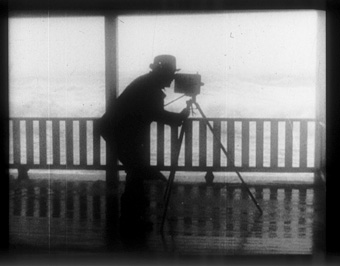
Passio
ONE OF THE DISTINCTIVE FEATURES OF THE PROGRAM FOR THE 2007 ADELAIDE FILM FESTIVAL (AFF) IS ITS EMPHASIS ON SILENT FILM WITH THREE STRONG ATTRACTIONS: PAOLO CHERCHI USAI’S PASSIO, ROLF DE HEER’S DR PLONK AND A SCREENING OF D.W. GRIFFITH’S INTOLERANCE WITH LIVE ACCOMPANIMENT BY LOCAL BAND, THE DEADBEATS. GIVEN THE GRAND CLAIMS FOR NEW MEDIA IN THE DIGITAL LANDSCAPE, IT SEEMS SIGNIFICANT THAT OLD MEDIA ARE SIMULTANEOUSLY RETURNING TO PROMINENCE.
One common thread linking AFF events is the relationship with live music which has sustained the renaissance of interest in silent film. Film theorists, for many decades, have noted that the diffusion of synchronised sound in the later 1920s and the rise of a dialogue driven cinema added to the realism of the image. These three projects, while with very different geneses, employing divergent aesthetic strategies and addressing different publics, all circle around the idea of returning the image to a space where it can interact as an equal with the more abstract structures of music.
Paolo Cherchi Usai is the Director of Australia’s National Film and Sound Archive, as well as one of the world’s most respected film archivists and historians. Passio, his feature compilation of found footage and calligraphy, accompanies Arvo Pärt’s musical adaptation of the Passion from The Gospel of St John. Pärt’s music will be performed by the Adelaide Symphony Orchestra with organist Christopher Bowers Broadbent and the Theatre of Voices directed by Paul Hillier.
Cherchi Usai has spoken of his interest in producing a dialogue between image and sound. To the extent that the film has a subject, he sees it as dealing with our society’s history of image production. He sees the sum total of our images as a kind of repressed collective memory, and in interviews he has invoked writers such as Mircea Eliade who emphasise the symbolic role of imagery.
He is also interested in the image as image in a very concrete sense. In an attempt to restore what Walter Benjamin called the aura of the individual artwork, lost in the age of mechanical (and now digital) reproduction, only seven prints of the film were struck before the negative was destroyed. Each print is hand-coloured in a different hue, with four cool prints (ruby, violet, indigo and magenta) and three warm prints (vermilion, gold and minimum colouring). No one print of the film is like another, just as no one performance of the work will be like another.
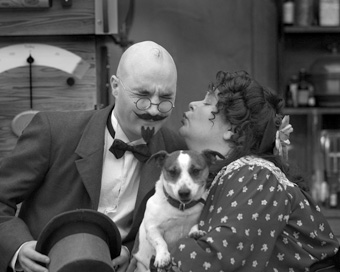
Dr Plonk
From the sublime to the ridiculous. In an industry where the hardest thing is to make your second film, Rolf de Heer was travelling with his tenth feature, the AFI-winning Ten Canoes, while cutting his eleventh, Dr Plonk, which is the AFF’s closing night film. By Australian standards, de Heer comes up with some pretty daring ideas. Having made a subtitled film in an indigenous language with a group of non-actors, he has backed up with a silent, slapstick comedy. To de Heer, these aspects of his career are related. “The more radical I get, the easier these things are to finance,” he said at a Media Resource Centre talk in Adelaide recently.
His last two films are linked in more pragmatic ways as well. The overrun in making Ten Canoes meant that de Heer needed to make another film relatively quickly. He tells of going to the fridge to get some insect repellent in preparation for a trip north and finding instead 20,000 feet of film stock past its expiry date. At that moment, he knew he had his next project: a film which would invoke the look of silent cinema, where any deterioration in the stock would be immaterial as it would be printed in black and white, and in a genre where we expect films to be far from pristine in condition.
Though the inspiration for Plonk stemmed from these humble beginnings, this was to be no simple project. De Heer says that many of his films “begin first as a contrivance and only after that become a great passion.” He decided that his silent film would have to be shot in the style of silent films—the slapstick comedies which he had seen on television in his childhood—but also employing as much of the technology as was feasible. He and cinematographer Judd Overton set about finding a hand-cranked camera to give the image a pulse in the inevitable variations in winding speed.
On first glance the project suggests comparison to Borges’ story about Pierre Menard who re-writes Don Quixote word for word in the present day—and in the process creates a completely different work. De Heer insists that the film “has to be its own thing. You can’t replicate silent film,” he explains, “but it’s in the tradition of silent film.” Some early attempts at technological authenticity were abandoned. The 1920s camera bought on eBay was jettisoned for a Mitchell modified for hand-cranking; black and white processing and cutting on film were replaced by digitising the negative for editing and then outputting back to film. An early plan to record a soundtrack on a theatre Wurlitzer was also abandoned in favour of an accompaniment by a Melbourne group, the Stiletto Sisters, which will be performed live at the Adelaide premiere (de Heer’s The Tracker was presented at the 2002 Melbourne Film Festival with Archie Roach performing live). The experimentation with sound that has characterised de Heer’s filmmaking has often taken the form of separating picture and sound as elements in their own right. The multiple strands of sound in Ten Canoes with David Gulpilil’s voiceover existing in a separate space to the narrative diegeses is another case in point.
Perhaps the most interesting concession de Heer had to make to an earlier style of filmmaking was the substitution of editing with complex staging. Rather than shooting standard coverage for an editor, the camera is held back in full shot, and like great filmmakers such as Feuillade, Bauer or Keaton, de Heer has to re-discover the craft of the early silent period—learning how to direct and quickly re-direct the audience’s attention to the salient dramatic business.
In a film so outlandishly different from Ten Canoes, de Heer has paradoxically come back to the same ground in Dr Plonk, with the need to find the formal means in picture, sound and drama to imagine a radically different time and place. Here is another attempt to regain the past, just as the protagonist of Ten Canoes has to recover the past of his ancestral cosmology before he can die, just as de Heer the image-maker tries to recover the past of anthropologist Donald Thomson’s photographs.
De Heer’s experiment in re-discovering cinema through anachronism is not an isolated one. In Wisconsin for instance, the university’s filmmaking department runs a course in silent filmmaking which tries to replicate as closely as possible the film stock, camera equipment, lighting conditions and processing technology available to filmmakers at the birth of the medium (mywebspace.wisc.edu/dhfuller/web). For film historians, the benefits are a closer understanding of the conditions and constraints faced by the filmmakers, while for those interested in becoming filmmakers, silent film offers a tangible encounter with the material basis of the medium in ways which have been lost by the “point and shoot, click and drag” methods of digital video.
The third silent program at AFF has its origin in the Media Resource Centre’s Silent Re-masters series, which has given rise to The Deadbeats’ accompaniment to DW Griffith’s 1916 classic Intolerance. Re-scores of silent films by rock groups or electronic musicians commonly polarise opinion. Some view it as a refusal to see history in any terms other than contemporary ones. For others, it acknowledges that these films were intensely modern and popular in their historical moment, and that as electronic and rock music occupy an analogous cultural space today, they can help translate the films into contemporary idiom.
Rather than play over the film, The Deadbeats (bass, drums, guitar, keyboard and spoken word picking out key intertitles) provide a spare accompaniment which accentuates the rising patterns of action within scenes. Intolerance, with its four interwoven narratives, stands up well to this treatment which refreshes the audience’s respect for the essentially abstract nature of Griffith’s achievement instead of facilely deriding it for its lack of realism.
Adelaide is not alone in foregrounding silent cinema within a festival context. The recent Berlin Film Festival programmed restorations of Giovanni Pastrone’s 1913 Italian epic Cabiria and Asta Nielson’s 1920 version of Hamlet. This rediscovery of silent film is undoubtedly a by-product of Pordenone’s Le Giornate del Cinema Muto, an annual festival begun 25 years ago by a group including Cherchi Usai, and which has included strands on 21st century silents, including filmmakers such as Guy Maddin. The lesson here might be that, as much as artists envision the future, there is something both perverse and prudent about turning in the other direction and absorbing the lessons that history has to offer on the production and consumption of screen images.
Adelaide Film Festival, Feb 22-March 4
www.adelaidefilmfestival.org
RealTime issue #77 Feb-March 2007 pg. 18
© Mike Walsh; for permission to reproduce apply to realtime@realtimearts.net
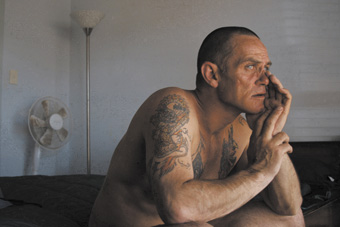
Richard Green, Boxing Day
KRIV STENDERS’ BOXING DAY IS A DOMESTIC DRAMA FOCUSING ON A MAN ON HOME DETENTION WHO UNCOVERS A DISTURBING TRUTH WHILE ATTEMPTING TO RECONCILE HIS ESTRANGED FAMILY. SOLELY FUNDED BY THE ADELAIDE FILM FESTIVAL AND UNFOLDING IN REAL TIME IN ESSENTIALLY ONE CONTINUOUS TAKE, THE FILM IS A FOLLOW UP, NOT JUST CHRONOLOGICALLY BUT METHODOLOGICALLY, TO STENDERS’ MICRO-BUDGET BLACKTOWN, WHICH WAS A HIT AT THE 2006 SYDNEY FILM FESTIVAL (WHERE IT TOOK OUT THE AUDIENCE AWARD), MELBOURNE, BRISBANE, PERTH AND CANBERRA FILM FESTIVALS.
Blacktown is shortly to be released on DVD by Madman Entertainment. Ahead of Boxing Day’s world premiere at AFF, I spoke to Kriv Stenders about his working methods, casting strategies and stylistic formalism.
“The seed for the film happened ten years ago when I made a short film called Two/Out,” says Stenders of his first collaboration with Boxing Day co-writer and star, indigenous poet, musician and sometime actor, Richard Green. “I met both Tony Ryan [star of Blacktown, RT67, p22] and Richard through making Two/Out. Richard and I stayed in loose contact, and when I made Blacktown with Tony I touched base with Richard. Then, because of the experience I had with Blacktown, I thought it would be great to make a film with Richard in a lead role. Basically having that experience under my belt I decided to do Boxing Day.”
The film’s scenario involves Green’s character, Chris Sykes, a recovering alcoholic and criminal, preparing Christmas lunch when an old friend turns up uninvited at his doorstep and reveals a secret regarding his family. When Chris’ daughter, his wife and her new boyfriend finally arrive, the situation inevitability escalates in tension towards revelation and conflict. Dark and relentless when compared to some of the relatively lighter and romantic moments of Blacktown, the film’s tone was dictated by Green’s presence: “ Tony [in Blacktown], who’s very gregarious, with a lot of light inside him, he was ideal for that type of film, while Richard is a lot more conflicted. I knew that he’d be able to play intensity really convincingly, absolutely perfect for some kind of heavily dramatic role. And it just kind of fed from there. Well, we thought, what about a siege situation? He’d be really good in that. How about that? What about a domestic situation, the ones you read about in the papers at Christmas when families go off the rails? Perfect. That’s where it started. Richard can do this sort of character. What kind of story would that character inhabit? Work with that, and the story kind of wrote itself from that point. And it became this kind of confronting, quite unrelenting piece. Hopefully with some kind of light in it as well.”
The writing process for Boxing Day never advanced to a full draft screenplay, but what Stenders calls a “scriptment”, which had precisely laid out story beats and sample dialogue, but with enormous scope for flexibility and improvisation. A limited cast of six and one location was suited to this form of organic evolution of narrative and character. “Basically we had a three week period to produce the film. So for the first two weeks we rehearsed the film chronologically, and shot it. At the end of the first week we had a version of the film, which we could sit back and watch. Every night I’d pick the best bits and cut it together. So at any point of the day we had the film, and we just added on the next dramatic layer. By the second week we had a second version of the film and we really knew what the weak points were, what the twists and turns were, and were really able to refine the story and address a lot of dramatic issues and character issues.” This was a more structured approach than the guerrilla approach to the making of Blacktown. “Blacktown was shot over about eight months. And it wasn’t as concentrated or disciplined as this. Boxing Day is a much more contained enterprise. It was more finite. But because we had finite resources and finite time, I think it worked really well, because it really helped focus everything.”
Stenders is a passionate advocate of backing the abilities of non-actors, as long as they bring an intrinsic talent and legitimacy to the role, and he encourages them in certain scenarios to construct their own dialogue and action. “Because you’re not bound by script or hitting lines, it can help alleviate stilted performances, and it’s important to get actors who are more like jazz musicians, who are able to improvise, riff off a melody, and come back to the basic rhythm again.” A non-actor, Stuart Clark, plays Chris’s drug-dealing colleague in Boxing Day, his services attained through contact with the Offenders Aid and Rehabilitation Services of SA. A similar process was used to cast Stenders’ short film Two/Out, “and it’s a risky thing to do because some of these guys are struggling with internal issues. But Stuart brought something inherent, he brought some authenticity and a lot of credibility to Boxing Day.” The end result of Clark’s natural performance is compelling, full of implied menace and idiosyncratic phrasing.
While most of the cast were taking their first roles, they were also offset by the presence of two professional actors in Syd Brisbane and Tammy Anderson. This blending of experience and rawness was very deliberate: “In a funny kind of way they feed off each other. Non-actors can be more tangential and unpredictable but the actors can always bring them into line, and vice versa…it’s all about casting. From my point of view directing is 99% casting.”
Trained as a cinematographer, Stenders himself shot Boxing Day with a hand held, intimately observational approach of one extended take in a digital format. Aware that this brand of cinematic experiment has been attempted before, he acknowledges predecessors like Russian Ark (Aleksandr Sukorov, 2002) and Time Code (Mike Figgis, 2000): “So it’s not that groundbreaking, but I think what’s different about Boxing Day is that we’re telling a linear story. It’s all about the story, really.” His ambition for Boxing Day is to balance an aesthetic style, a narrative structure, and the technology of the medium, into something cohesive:
I really love digital as a medium and I really like to find new ways of telling stories to make films. In a funny kind of way, I think digital has been the best thing to happen to cinema in the last twenty years, because the freedom it gives you to work outside of normal systems, styles, formats or traditions is great. So I wanted to do something where the form and content were the one thing and kind of inform each other. And I just really like the idea of doing long takes, and never cutting and always being in the moment.
Having made Illustrated Family Doctor, a traditional feature on 35mm—although that was a lot of fun—the thing I learn as I make more and more films is that if I frighten myself, if I put myself in compromising positions I find that the payoff is more rewarding than by being safe.
Adelaide Film Festival, Feb 22-March 4, www.adelaidefilmfestival.org
RealTime issue #77 Feb-March 2007 pg. 17
© Sandy Cameron; for permission to reproduce apply to realtime@realtimearts.net
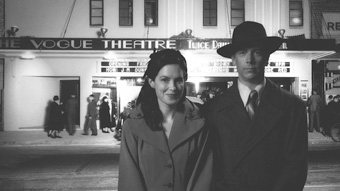
Alma (Victoria Hill) & Rupert (Ben Mendelsohn) at Vogue
photo Rose Draper
Alma (Victoria Hill) & Rupert (Ben Mendelsohn) at Vogue
LIKE AN AUSTRALIAN VERSION OF TIM BURTON’S ED WOOD (1995), HUNT ANGELS (ALEC MORGAN, 2006) IS A BIOPIC ABOUT A NOT VERY SUCCESSFUL, BUT VERY PASSIONATE, PAIR OF FILMMAKERS STRUGGLING OUTSIDE THE HOLLYWOOD RUN SYSTEM IN THE EARLY YEARS OF CINEMA. STARRING BEN MENDELSOHN AS THE FAST-TALKING RUPERT KATHNER AND VICTORIA HILL AS ALMA BROOKS, HIS ALLURING YOUNG CAMERAWOMAN, THIS SAD TALE OF THE DUO’S PERSISTENT BUT DOOMED STRUGGLE TO TELL AUTHENTIC AUSTRALIAN STORIES IS PORTRAYED IN SUMPTUOUS BLACK AND WHITE ART DECO STYLE.
Seamless computer manipulation embeds the two actors into stills and newsreel footage from the 1930s and 40s and intercuts them with interviews of still living contemporaries. Hyper-stylised mise-en-scène is reminiscent of film noir. Costuming and makeup is authentic to the period and immaculate. Even the transitional wipes from re-enacted footage to present-day interviews have the feel of the 30s. The use of matting and green-screen recording of the two actors playing the forgotten filmmakers integrated into hundreds of archival images has resulted in a documentary film consisting of 281 special effects shots, which “deploy…contemporary electronic means to fuse together the story of two filmmakers ‘lost’ from our written history with ‘lost’ images of Sydney of the era in which they lived” (Alec Morgan, “Re-telling history in the digital age: The scripting of Hunt Angels”, Scan: Journal of Media, Arts, Culture).
With more chutzpah than talent, Kathner and Brooks made nineteen films before ‘Rupe’ died of a brain hemorrhage in 1954 at the age of 50. Unfortunately, none of these bear scrutiny today, especially when stacked against the better funded works of their contemporary cinemateurs such as Charles Chauvel, whose Rats of Tobruk (1944) scuttled Kathner and Brook’s own plans of a desert war saga. Despite being pioneers in Australian cinema, their contributions don’t even rate a mention in the Australian Film Institute’s A Century of Australian Cinema (1995). The short-lived screenings of their films took place only in the so-called ‘flea-pits’ of Sydney, because, as David Stratton points out, “the two main cinema chains were majority owned by foreign companies (Hoyts by 20th Century Fox and Greater Union by Rank Organization)“, (“A true Aussie gem”, The Weekend Australian, December 2-3, 2006), and these cinemas could only play films sanctioned by the Hollywood owners.
Distribution was monopolized by Hollywood companies, too. Rarely were Australian-made features screened and Kathner and Brooks were under constant financial strain, with many of their filmmaking ventures being little more than scams to milk money from gullible investors, or ‘angels’. Morgan explains their appeal: “They were partners in moviemaking, love, and (as it turned out) crime” (“Lost city of the senses”, Scan: Journal of Media, Arts, Culture). For their Pyjama Girl Murder Case (1939), Australia’s first ‘true crime’ movie, Alma stripped and lay in a bathtub, pretending to be a corpse that had been steeped in formalin for five years, because access to the real thing was denied by the NSW Police Commissioner, “Big Bill” Mackay. The pair’s earlier break-in to the Sydney University Medical Faculty to film the body failed due to lack of a replacement bulb when their only lighting rig blew. Finally, to get permission to continue with the film, Kathner manufactured death threats against himself and ‘leaked’ them to the media: “Big Bill” relented and the film was completed.
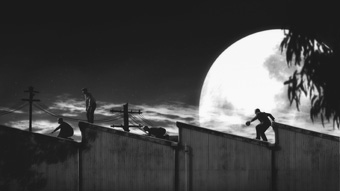
Hunt Angels
photo Rose Draper
Hunt Angels
After a state ban on bushrangers in film was overturned in 1946, the pair’s Ned Kelly film, The Glenrowan Affair (1951) employed numerous different leads according to whomever they could con. The movie’s ‘stars’ came from grazing properties around Victoria’s ‘Kelly country’ and contributed financially in return for the leading role. As a result Kathner and Brook’s ‘Ned’ was variously short, tall, fat and thin. Although the feature films with which they unsuccessfully took on the Hollywood stranglehold have all but sunk without a trace, with none ever turning a profit, Kathner and Brooks did contribute significantly to the newsreel genre, by depicting the actual misery and squalor of the Depression era in their Australia Today pieces of 1938-40, which were in stark contrast to the artificially optimistic Fox-Movietone News and Cinesound Review newsreels. Morgan laments the habit of historical surveys of Australian film to overlook the newsreel at the expense of features:
Because of the exclusion policies of Fox and Cinesound, moving images of the poorer, noir world of Sydney that Kathner and Brooks inhabited and filmed are missing from our popular memory. Generations have grown up seeing a Depression-era Sydney depicted as a sunny, prosperous place with beaches full of happy bathers and bronzed lifesavers. Even today, because of their easy access, the Fox-Movietone and Cinesound News collections are the most extensively used sources of factual footage of that era. (“Re-designing the past imperfect: The making of Hunt Angels”, Senses of Cinema, 2006).
By depicting Depression-era Australia as it really was, Kathner and Brooks should have earned a place in Australia’s cinematic history, but their fringe existence has meant they have been under-screened and overlooked…until now, that is.
Biopics of filmmakers have not been common in Hollywood: apart from Burton’s Ed Wood, Bill Condon’s Gods and Monsters (1998) about horror film director James Whale also springs to mind. Morgan’s work is the first biopic of an Australian filmmaker: biopics here have included a sports star, Dawn Fraser in Dawn! (Ken Hannam, 1979); criminals, Mark ‘Chopper’ Reid (Chopper, Andrew Dominik, 2000) and Brendan Abbott (The Postcard Bandit, Tony Tilse, 2003); a writer, Miles Franklin (My Brilliant Career, Gillian Armstrong, 1979); a pianist (David Helfgott in Shine, 1996); and Ned Kelly in a plethora of films. One commonality in Australian biopics is the recurring theme of a unique individual’s struggle against the establishment. But the underdog need not win: Albert Moran and Errol Vieth note in Film in Australia in their chapter on the Australian biopic: “there is no obligation on the genre to trace an ever-upward path on the part of its central figure. Triumph and affirmation may only be incidental moments in the biographical film” (Film in Australia, Melbourne: Cambridge UP, 2006). Kathner and Brooks were certainly underdogs.
Nevertheless, Hunt Angels serves as an instructional piece for contemporary Australian filmmakers, who have it comparatively easy. Since the 1970s Australian filmmaking has been greatly assisted by the state film development organisations in what has been called The Revival. Before this financial revitalisation, cinema in Australia was a mostly US lead affair: 95% of films screened were US productions distributed by US firms and shown only in cinemas they approved. This was the hostile environment in which Kathner and Brooks operated. Paul Kathner says in the film: “My father wanted to tell Australian stories—he was fed up with the Americanization of films.”
It is this passion to break away from Hollywood controlled production, distribution and screening and to tell Australian stories that drove Kathner and Brooks. It is this same intention to do things in an anti-Hollywood way that seems to have driven Morgan to choose two movie-making failures to be the subject of a film. Moran and Vieth write of the Australian biopic, “What matters is not the historical importance of the life but rather that the life actually happened. Beyond that, generic form and style intervene to ensure that the biographical subject becomes a screen subject.” Morgan creatively uses Art Deco style and form to turn a forgotten biographical subject into a captivating screen subject, something that would never have seen the light of day were it a story about two unknown filmmakers in Hollywood. Instead of choosing a successful Australian cinematic legend like Charles Chauvel, the subject of numerous historiographies, Morgan has disclosed the quondam reality of our lesser-known Australian movie-making background. As David Stratton has said of Hunt Angels, “if you care anything about local cinema, the result is essential viewing.” Hunt Angels has filled in a small blank in our cinematic and cultural history, re-coloured an effective whitewash of the Depression-era wretchedness of Sydney by Hollywood sanctioned sanitised newsreels, restored a nation’s previously censored memory, and done so with an unmistakable anti-Hollywood sneer.
Hunt Angels won the 2006 Film Critics Circle Australia Award for Best Feature Documentary and the Atom Award for Best General Documentary.
Hunt Angels, writer-director Alec Morgan, cinematography Jackie Farkas, lead compositor and visual Fx supervisor Rose Draper, visual effects consultant and post-production supervisor Mike Seymour, production designer Tony Campbell, costumes Margot Wilson, editor Tony Stevens, composer Jen Anderson, producer Sue Maslin; Palace Films with Film Art Doco and Blusteal Films, 2006 www.huntangels.com.au
RealTime issue #77 Feb-March 2007 pg. 24
© bruno starrs; for permission to reproduce apply to realtime@realtimearts.net
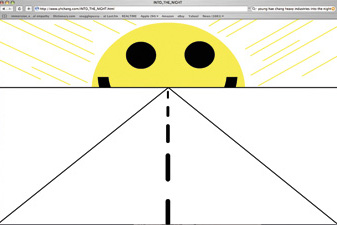
(Out of the Internet and) Into the Night, Young Hae Change Heavy Indsutries
IN A LARGE STUDIO ADJOINING THE NEW STATE LIBRARY OF QUEENSLAND, MAAP 2006 OFFERS VISITORS INTIMATE, INTENSIVE BROWSING OF MEDIA ART IT HAS COMMISSIONED AND COLLECTED. THE LIBRARY, A PARTNER IN MAAP'S OUT OF THE INTERNET, IS IMPRESSIVE ARCHITECTURALLY, IN SCALE AND IN THE ARRAY OF SCREEN AND COMPUTER FACILITIES AVAILABLE TO USERS. IT'S WELL PLACED AS PART OF THE SOUTHBANK CULTURAL PRECINCT BETWEEN THE QUEENSLAND ART GALLERY AND THE SPECTACULAR NEW GALLERY OF MODERN ART. MAAP FITS WELL IN THIS SCHEME OF THINGS, EMBRACING AND INTERROGATING NEW MEDIA WORK AS ART AND SIMULTANEOUSLY AS PART OF GLOBAL COMMUNICATION NETWORKS.
In titling MAAP 2006 Out of the Internet, artistic director Kim Machan was hoping to give internet art a palpable exhibition presence as well as an online life: “I am shepherding the work back into taking a material form in the museum context, to achieve authority, blending the different fields in which they operate, and joining another official art history context. Making a representation of all the works in the State Library of Queensland adds another dimension—or escape route—out of the closed museum context” (RT 75, p2).
This physicality manifests itself for visitors too. Near the entrance to the exhibition, on Singapore based artists Charles Lim and defence scientist Melvin Phua’s exercise rowing machine, alpha 4 (GENERATOR), you work hard until the point at which you’ve powered up the battery which kickstarts a computer that is set up as a server for its own website and which sends the image of you rowing out around the world. As Machan observes in her catalogue notes, there’s something dryly funny about an “overly earnest scientific approach coupled with the absurdly circular demonstration.” This is interactivity that not only makes you work but triggers ideas of bizarre potential applications.
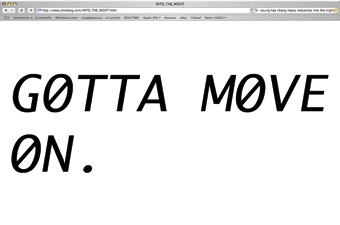
(Out of the Internet and) Into the Night, Young Hae Change Heavy Indsutries
In the relaxed MAAP exhibition space, scaffolding creates a second level to which you climb to view YOUNG-HAE CHANG HEAVY INDUSTRIES’ flash animation, Into the Night, on a big screen, or look left to another featuring G’day, G’day by Japan’s Candy Factory. Beneath the floor are rows of video monitors on which, with headphones, you can choose to view a host of DVD-based works from the Move on Asia Clash & Network Exhibition originally shown in Seoul and Tokyo and, once sifted through, featuring some strong work. A seat per screen makes the experience a serious as well as comfortable one (galleries take note). In Zhong Shuo (People say…; Australian artist Iain Mott with Chinese collaborators li Chuan Group, Ding Jie) you can set yourself down on cushions in a small house to hear Chinese people speak of their experience of cities as they change (www.reverberant.com; RT 71, p26).
As promised by Machan, YOUNG-HAE CHANG INDUSTRIES’ Into the Night offers a cinematic version of what is usually an internet experience. The Korean pair have created a wickedly witty text rendition of a film-noirish road movie replete with the artists’ own fine jazz score backing a hilarious argument in aptly dead-pan computer-generated speech. The only concessions to imagery (the scale, distribution and lyrical movement of the words make the art here) come in the form of road markings flickering into the distance and a happy face sun on the horizon. There’s a shocking crash (the word falls off the screen) and fitting closure after droll renditions of Talk About It and Funky Town: “You kill me.” Go to www.yhchang.com to see Into the Night, and many more inventive works, on the small screen, but it must be said: BIG is good.
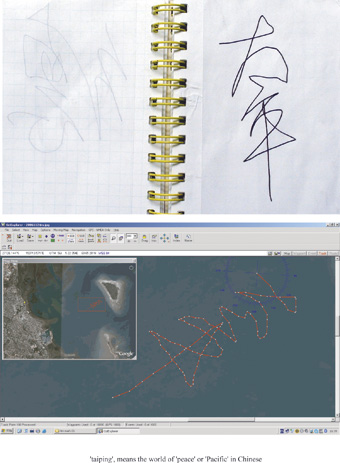 Feng Mengbo, The Invisible Words: A GPS Calligraphy Project, 2006,
Feng Mengbo, The Invisible Words: A GPS Calligraphy Project, 2006,
Moreton Bay, November 2006
As with Candy Factory and Young Hae Chang, Feng Mengbo (China) has a longstanding relationship with MAAP. GPS technology is employed quite laterally in his appealing Invisible Words installation. He uses it to ‘write’ Chinese characters across city maps (www.maap.fengmengbo – expired) and oceanographic charts. The artist travels the route (in “kilometres’ long brush strokes”) determined for him by the shape of a an ideogram and records the result as he goes. For MAAP he worked off the coast of Queensland. The finished exhibits, where the techno-calligraphy hovers beautifully between the impressionistic and precise, are accompanied by images of the artist ‘writing’ at sea. RT
MAAP: Out of the internet, artistic director Kim Machan, State Library of Queensland and international partner venues, Nov 30, 2006-Jan 25, 2007; www.maap.org.au. For the full extent of MAAP Out of the Internet activities see Danni Zuvela’s interview with the curators in RealTime 75.
RealTime issue #77 Feb-March 2007 pg. 34
© Keith Gallasch; for permission to reproduce apply to realtime@realtimearts.net
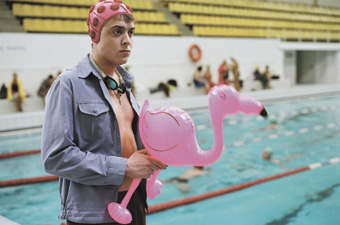
Yuri Chursin, Playing the Victim
RUSSIANS SEE THINGS A LITTLE DIFFERENTLY FROM WESTERNERS. TO THEM, LIFE IS BLEAKER, STUPIDER, DEEPER, FUNNIER AND ALWAYS MORE ‘HUMAN.’ THEIR FILMS REFLECT THIS PERSPECTIVE. THERE IS ALWAYS AN AUDACITY IN RUSSIAN CINEMA. EVERYTHING SEEMS TO BE HANGING, TENUOUSLY ABOVE AN OCEAN OF CHAOS. IN AUSTRALIA, WHERE LIFE IS TOO SAFE AND EASY, IT’S LIBERATING TO OBSERVE SUCH ARTISTIC RECKLESSNESS. RUSSIAN FILMS CAN SHAKE OUR BENEVOLENT PLATITUDES, REAWAKENING OUR SENSE OF COLD, INVIGORATING REALITY. FORTUNATELY, THE 2007 ADELAIDE FILM FESTIVAL WILL BE SHOWCASING SIX DIVERSE EXAMPLES OF NEW RUSSIAN FILMMAKING TO REMIND US OF THE POWER OF THIS INIMITABLE NATIONAL CINEMA.
At the top of the list in this year’s season is Alexander Sokurov’s The Sun (2004). For the uninitiated, Sokurov is the most accomplished filmmaker working in Russia today, largely known in Australia for his single-shot historical panorama Russian Ark (2002). The Sun presents the third instalment in his Men of Power series. Following depictions of Hitler in Moloch (1999) and Lenin in Taurus (2001), The Sun focuses on the life of Japanese Emperor Hirohito in the days leading up to his capitulation to the US led invasion in 1945. A biography of sorts, it follows Hirohito (Issei Ogata) through the twisted layers of his character, through its defects and peculiarities, towards the moment when he will renounce his sanctified divinity as a sun god for the sake of international peace and personal happiness.
A controversial work, Sokurov’s film has generated considerable hostility in many countries, particularly in China where its sympathetic depiction of Hirohito has been received as an insult to the victims of Japanese atrocities. Indeed, as historical record, The Sun is at best problematic. But history is not the film’s real interest. What Sokurov captures is not the life of a man as normally understood, but rather the bare emotional imprint of a life, of a human animal clothed in an illusion of ritualised power and sickness. The style reflects this concern. Green-brown sepia images and warped, fluctuating proportions conjure disease or hallucination. Hirohito himself notes an ever-present “bad smell and bad taste”, sensations exacerbated by the score’s remarkable arrangement of music and noise into a low intestinal drone. Like the best of 19th century Russian literature, Sokurov reveals the aura or tone of each scene, isolating the human experiences within it. Perhaps the film’s greatest asset is the actor Ogata. His performance as Hirohito is quite unlike any I have ever witnessed, not so much that of a psychology as of a soul: anguished, silent and invisible. These qualities give The Sun an artistic value rarely matched in contemporary filmmaking.
Pavel Lunguin’s The Island (2006) belongs to the same school of Russian filmmaking (one traceable to the influence of celebrated director Andrei Tarkovsky). A less complex film than The Sun, The Island is a character centred study of sin and redemption. Having washed up on the shores of a remote monastery, Father Anatoly (Petr Mamonov) spends his life segregated from the rest of the order as an eccentric prankster and mystic. He administers to the sick, plays tricks on other priests and makes a general mockery of Orthodox ritual, all to encapsulate a genuine example of Christian faith: devotion to God and nothing else. But the pain of his past sins will not go away. Impressively shot on a lavish budget, The Island is propelled by a wonderful performance from Mamonov, whose Anatoly humanises the script’s religious concerns with compassion and warmth. It’s a serious film, but accessible.
In a totally different realm is Kirill Serebrennikov’s black and dry comedy, Playing the Victim (2006), recently voted Best Film at the Rome Film Festival. Previously anonymous as a filmmaker, Serebrennikov has experienced considerable success over the past ten years as a theatre director of contemporary and usually scandalous Russian plays. His new film sees him bringing one such work to the screen, Playing the Victim by brothers Vladimir and Oleg Presnyakov. It begins unabashedly: “Russian cinema is in big shit. Only Fedya Bondarchuk is a cool guy. Fedya is cool. His father got an Oscar. And he’ll get one. He’ll get stronger and get one for sure.”
To those in the know the message is clear. This is anti-Tarkovsky, a film concerned only with this life. It is the story of Valya, a near thirty-year-old boy, university graduate and emblem of a new way. Valya works for the police. His job is to stand in for the dead during re-enactments of homicides. It’s cushy work and pays enough for his new toys and clothes. But Valya’s real interest is in revenge: on his mother and uncle who now share his dead father’s bed, and on an entire generation of Russians busy reacquainting themselves with national arrogance. He endorses something else entirely, the cultural ambivalence of anything and everything. Valya practices his gangsta moves, eats blackberries with chopsticks and embraces suicide chic with the best of them. To generations X and Y his stance will be a familiar one. “Ideals don’t exist”, the film’s director has claimed, “and it would be good to have a great deal more common sense…I don’t think we have our own special path or destiny” (The Moscow Times, June 9, 2006). The Russian cultural elite will be rolling in their graves.
Everyone knows that Slavs are the best at being seriously idiotic and First on the Moon (2005) proves it in spades. A mockumentary by Alexei Fedorchencko, it lets us in on a big secret. While many of us are aware that Neil Armstrong’s famous giant leap was filmed in a television studio, few of us have known the whole truth until now. The real, bona fide Moon landing was an unadulterated Stalinist invention. Encased within a prototype interstellar projectile, a small handpicked elite of heroic workers, athletic beauties and limber midgets shot to the Moon on March 16th 1938, returning to Earth one week later as a meteor that landed in a remote alpine region of Chile. The crew survived, its superhuman leader Ivan Kharamalov evading Soviet authorities by assuming multiple identities. He eventually became star of a popular regional circus troupe in a vibrant retelling of Alexander Nevsky. If you don’t believe me go and see First on the Moon yourself. This is a brilliant and hilarious film with fantastic black & white imagery. It won best documentary at the 2005 Venice Film Festival.
At the other end of the truth spectrum is Sergei Loznitsa’s documentary Blockade (2005). Winner of 6 international prizes, Blockade comprises newsreel footage from the 900-day siege of Leningrad (1941-44) during which up to 800,000 Russians died. Choosing to let the footage speak for itself, Loznitsa couples the images only with a minimal soundtrack of effects. For 52 minutes we watch silently on the domestic consequences of war. It is a harrowing and starkly pertinent experience for anyone still unsure about the viability of military invasions.
Finally, Andrei Kravchuk’s The Italian (2005) fulfils an all too often neglected role in festival programs. It’s a children’s film, most suitable for 12-15 year olds. It tells the story of Vanya, a five-year-old living in a dilapidated Russian orphanage. Vanya is lucky. From the dozens of boys surrounding him he has been chosen for adoption by a childless Italian couple. In only a month it’ll be beaches and gelato. But Vanya doesn’t feel lucky. He wants what is his. With a gritty resolve and a knack for language he escapes the orphanage and embarks on a journey to find his real mother. Like the best children’s films, The Italian layers its adventure story with a sophisticated social analysis, presenting a cross-section of Russia’s past and present through the lens of Vanya’s unclouded eyes. It won Best Children’s Film at the 2006 Berlin International Film Festival.
Adelaide Film Festival, Feb 22-March 4,
www.adelaidefilmfestival.org
RealTime issue #77 Feb-March 2007 pg. 19
© Tom Redwood; for permission to reproduce apply to realtime@realtimearts.net
IN CHARLES STROSS’ SCI-FI NOVEL THE SINGULARITY SKY, CULTURAL COLONISERS INVADE A PLANET WITH CORNUCOPIA MACHINES WHICH CHURN OUT EVERY KIND OF OBJECT AND TECHNOLOGICAL DEVICE ON THE INHABITANTS’ WISH LIST IN RETURN FOR THEIR IDEAS, HISTORIES AND BELIEFS. THE ALIENS, WHO ARE NEVER SEEN, LEAVE THE PLANET AND ITS CULTURE IN A RIGHT MESS, RUINING THE ALREADY DODGY DISTRIBUTION OF POWER. THE AUSTRALIAN NETWORK FOR ART AND TECHNOLOGY (ANAT) IS A VERY DIFFERENT KIND OF CORNUCOPIA MACHINE, A BENIGN ONE HELPING US MAKE THE MOST, ETHICALLY AND AESTHETICALLY, OF THE NEW TECHNOLOGICAL TOOLS WE ARE FLOODED WITH BY OUR OWN ALIENS, THE TECHNO-CORPORATIONS.
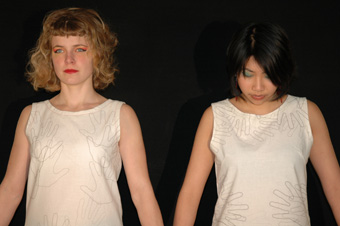
Finger Dress, Joanna Berzowska
courtesy of the artist
Finger Dress, Joanna Berzowska
When I comment on the apparent fecundity of ANAT’s 2007 program, director Melinda Rackham informs me that, of course, Anat is the ancient Egyptian goddess of fertility and crops, and of war. Even so, the program is not quite the horn of plenty Rackham envisaged given limits on funding, consequently “there was some cutting back. So we’re really looking for partners and sponsors outside grant funding in order to employ additional staff to make what we’re doing sustainable.”
in the loop
One of Rackham’s passions is keeping media artists informed, in touch, in the loop. A highly developed mailing list is vital and she’ll look to the model she employed when she instigated the empyre list with its moderated discussions and papers in 2002 (www.subtle.net/empyre). ANAT will also revitalise the lapsed Synapse Database, “an online resource promoting the nexus of art and science”, by bringing writers and curators as well as artists and scientists into its fold (www.synapse.net.au). Because media arts have difficulty connecting with the wider community, says Rackham, it’s vital to attract a diverse audience, “like the scientific community or Cosmos readers [www.cosmosmagazine.com], people who enjoy reading about science. We have to make media arts more visible.” As well, ANAT’s new website, Artport, will play a major role in identifying and promoting artist and organisation members, integrating a diverse field and, as well, reaching out to artists in other fields and a wider audience, “working like a rhizome.”
everyday potentials
A sizeable part of ANAT’s current focus is on the technological innovations pertaining to everyday life. While attending festivals in recent years Rackham noticed developments in techno-wearables. She was alert to how “textile manufacturing and computing shared the same root—think the Jacquard loom and the difference machine. Why not take a different tack and reunite them. It’s aesthetic, it’s fun, technologically advanced and pushing at the edges.” Some wearables are eminently useful, many of them playful and some surreal: Rackham cites the “really practical handbag you can scream into in public places and let the cry out later.” But she also mentions Aphrodite shoes; designed initially for the safety of prostitutes, they are fitted with GPS receiver, alarm and back-to-base signal. (www.theaphroditeproject.tv/saftey). Meanwhile major fashion companies, especially in Italy, are alreading marketing ‘techno-couture’: “Zegna’s parka with pores that open and close, Valetino’s waterproof cashmeres and Alexander McQueen’s papier-mache leather” (“Made in Milan”, Australian Financial Review, Jan 25-28).
The upshot of Rackham’s interest is Reskin, a two-week intensive workshop for Australian media, visual arts and craft practitioners led by prominent overseas makers in the field and related practices: Joanna Berzowska (a Montreal expert in responsive textiles and clothing), Susan Cohn (a Melbourne goldsmith and designer), Stephen Barrass (Canberra-based interaction designer and artist), Elise Co (Los Angeles-based multimedia designer and programmer), Alistair Riddell (Canberra-based interaction design artist and researcher) and Cinammon Lee (Canberra-based metalsmith). Berzowska’s many imaginative and often amusing creations include “memory rich clothing” pictured on this page in the form of a “finger dress”: it’s “an intimacy map of the body, recording and displaying where a person has been touched” (www.berzowska.com).
Rackham is impressed with the high calibre of the Australian artists involved in the workshop (including Keith Armstrong, Somaya Langley, Catherine Truman, Michael Yuen, Robin Petterd) and notes that ANAT, a media arts organisation adopted as a client of the Visual Arts Board in the wake of the recent Australia Council restructure, is leading the way for the board’s traditional clientele in engaging with technological innovation and in an international context. In RealTime 78 Dan Mackinlay will report on the Reskin exhibition and forum.
pixel.play & portable walls
ANAT staff member Sasha Grbich, was one of the EPIC (Emerging Producers in Community) team (RT73, p9), focussing on mobile phone art in regional areas in South Australia with ANAT in the pixel.play program. The next stage of pixel.play is Portable Walls which, says Rackham, “is an outgrowth of the EPIC program and has really grown on its own”. Portable Walls will exhibit on phones and accessible, small DVD player screens the work of young makers and, depending on sponsorship, could tour to over 20 suburban and regional centres around Australia. Rackham says that if she’d seen this kind of art in a gallery when she was growing up in Tamworth: “I would have become an artist much earlier. Exposure of work that we take for granted in the cities is vital in the regions.” Pixel.play will show as part of the 2007 Come Out Youth Festival in Adelaide, May 7-19, featuring work on mobiles from 24 schools in the Mercury Cinema foyer (www.comeout.on.net).
opensourcing
The Annual ANAT Media Lab is titled Still Open, comprising two-day workshops in Perth, Melbourne Brisbane in conjunction with the Biennial of Electronic Art (BEAP07) and SymbioticA, Perth, Open Channel in Melbourne and Creative Commons at QUT, Brisbane. The focus is on opensource, the collective authoring of software, specifically the Linux operating system as a model of democratic and low cost cooperation. The workshops aim “to provide hands on experience; and to initiate local networks and projects.” The emphasis will be on the application of opensource practice and theory to “networked art and software development, print and online publishing, and in the scientific arena where the open science movement encourages a collaborative environment in which science can be pursued by anyone who is inspired to discover something new about the natural world.”
The Lab facilitators are publisher and media artist Alessandro Ludovico (Italy) producer of the online and print publication neural (www.neural.it); free software hacker and new media activist Andy Nicholson (Australia); and interdisciplinary artist and researcher Beatriz da Costa (USA), a former collaborator with the Critical Art Ensemble who works in open science.
The title Still Open was designed to match BEAP07’s stillness theme, but is also an apt reminder, says Rackham, that opensource is still a key media factor and “that there’s more to life than Microsoft and iPods.” Asked about the relatively brief duration of the workshops, Rackham points out that the cost of the lab is considerable and that after their two-day workshop experience, participants will stay in the loop, online with interstate workshoppers. She comments that in a climate where too many things are done on the cheap, ANAT’s big investment has been in Reskin and that she has effectively put one and half years of ANAT workshop funding resources into the event to ensure that it is of a scale to make it truly worthwhile, to influence artists and to push the work out into the community, “to really build on what we have started.”
new niches
ANAT is continuing its vital Professional Development Travel Grant program: the organisation’s membership magazine, Filter, documents artists’ reports on their travels. The grants take many artists overseas to research and develop their art and provide the potential for exhibition and collaboration. The Synapse Art and Science Residency Program is particularly targeted at developing “dynamic creative and collaborative partnerships between scientists and artists, science institutions and arts organisations.” The program is managed by ANAT as part of the Australia Council InterArts Office’s Synapse Art and Science Initiative. With two local residencies already completed in the second program, an international residency will occur at Rothamstead Research, Hertfordshire, UK assisted by Arts Catalyst, the UK equivalent to Synapse. Lynnette Walworth will take up this residency early in 2007 for eight weeks. Synapse Art and Science Residency Program 3 will extend the program into the Asia Pacific region. For Arts Victoria ANAT is now managing the AIR (Arts Innovation Residency) Art and Science Residency Program with three residencies to enable Victorian scientists and artists to develop collaborative research and projects during 2007. ANAT is also a member of Arts Active, a currently office-less international gathering making the most of the residencies boom, says Rackham, not just in universities but in commercial laboratories.
through the portal
ArtPort, ANAT’s radically refurbished website will be launched in 2007, shrinking distances nationally and internationally to connect Australian artists with each other and the world, making them, says Rackham, more visible and approachable. Artport will detail the careers and achievements of member artists and organisations; it will stream works; house the Synapse Database site; provide a media arts portal; and archive ANAT’s history as it approaches its 21st birthday.
soundings
Also in the pipeline for 2007 is Synthesia, a DVD with sound, images and critical writing by some of Australia’s leading experimental sound artists. Rackham is committed to ANAT “exploring sound culture in as many ways as possible.”
the ANAT role
I ask Rackham about ANAT’s role. It’s not quite like the politically active National Association of Visual Arts (NAVA): perhaps that will be the role of the Australian Media Arts Organisation (AMAO) if it gets past the incipient stage. Rackham says that ANAT’s role is to educate the public, make media arts more accessible and push for more funding by showing that the media arts are indispensable. To this end, as well as ANAT running a strong program, Rackham sits on a wide range of committees.
I ask about the mood of Australia’s new media artists. “Pretty depressed”, replies Rackham, as indicated by the lack of funding applications to the Australia Council and a general lack of exposure. However, she feels that “confidence is returning and that the Australia Council is really trying to reach out to artists.” She herself, as an award-winning net artist, finds the failure of Australian institutions to support the form exasperating; overseas it is thriving. Similarly she feels that while work on locative media is strong it should be taken up extensively in the community arts area because of its accessibility and artistic potential. The commitment to developing locative media art is, she says, much stronger in the US. Overall, Melinda Rackham feels that emerging practices, like work in techno-wearables, need to be rewarded so they can develop to their full potential and give hope to the young artists engaging with them.
www.anat.org.au/reskin
Great new images of prototypes produced in the reSkin lab are now available for download: http://www.flickr.com/photos/reskin/sets/72157594520118616/
RealTime issue #77 Feb-March 2007 pg. 25
© Keith Gallasch; for permission to reproduce apply to realtime@realtimearts.net
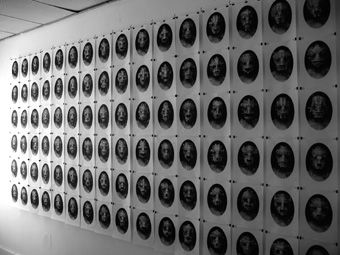
Murray McKeich, pzombie installation
photo Jonathan Rann
Murray McKeich, pzombie installation
THE SMALL, HIDDEN-AWAY ROOM IN MELBOURNE’S CBD HAS SOMETHING OF THE AIR OF A FORENSICS LAB. FACES, LIKE RETRO-FUTURISTIC MUG-SHOTS, ADORN THE MAIN WALL. AT FIRST THIS IS SUGGESTIVE OF THE REPLICATION OF THE SAME IMAGE—UNTIL THE INDIVIDUAL PATHOLOGY OF THE SUBJECT’S PHYSIOLOGY BECOMES UNNERVINGLY APPARENT.
Murray McKeich has been using computer technology for many years to create his macabre imagery. But it has none of the high-gloss or hi-tech aesthetics that so often characterises such work. Indeed, McKeich’s approach suggests the opposite; it is in his abuse of technology that the potency emerges.
For all of the cool, medical-examination style of installation, what creates the grit in these works is McKeich’s materials. He uses rubbish as his source material; all sorts of rotting, stinking, putrid crap oozing all over his state-of-the-art technology. When he scans his detritus it may clear away the smell, but not the hint of malevolent, maggot-ridden rot.
McKeich titled this body of work pzombie. Does this make his zombies postmodern zombies, psychotic zombies (aren’t they all?). Is he investigating the psychology of zombies or, as Kirsten Rann suggests in her accompanying essay, perhaps McKeich is investigating the philosophical “discourse in the field of cognitive science, specifically in relation to human consciousness.”
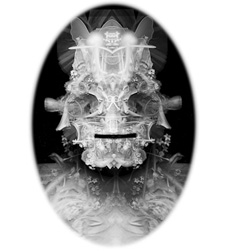
Murray McKeich, pzombie
The zombie seems to be rampant in popular culture. There are the literal, obvious references in such recent films as 28 Days Later and the remake of Dawn of the Dead. There are hints of zombification in Cormac McCarthy’s recent novel The Road. And I would not be the first to watch news footage of White House press conferences and wonder about a certain individual. The zombie is, in popular culture, the embodiment of evil, a flesh eating and mindless ogre. A pzombie, as Kirsten Rann points out in her catalogue essay, is in fact a real term in discussion of the mind and taking this further into the realm of artificial intelligence—what in fact it means to be conscious.
But McKeich’s pzombies may also be the stunned and stunted results of information overload. They are most certainly, if not brought back from the dead, then constructed from death, decay and detritus—doll’s heads, chicken bones, rotting lettuce leaves—a suppurating morass constructed in a hyper-drive voodoo ritual of McKeich’s own devising. And of course voodoo spirituality runs like a thick succor through such epics as William Gibson’s Neuromancer and the Wachowski Brothers’ Matrix series. And, although it has by now become a cliché, McKeich is most definitely enacting Gibson’s now-famous catch phrase: “The street finds its own use for things.”
McKeich’s pzombies are deeply creepy. They are mug shots from hi-tech hell and one wonders if these ‘portraits’ aren’t the result of what we now witness not just via the news, as gory as that can be, but what we dub ‘entertainment.’ Writing on the television series CSI in The Guardian newspaper last year, the author JG Ballard articulated this succinctly:
Lurid computer graphics provided flashbacks to the actual homicides, a stomach-churning revelation of what actually happens when an axe strikes the back of the skull, or a corrosive gas gets to work on the lungs…Light and safety are found only in the crime lab, among its high-tech scanners and its ruthless deconstruction of human trauma.
I suspect that the cadavers waiting their turn on the tables are surrogates for ourselves, the viewers…I fear that we watch, entranced, because we feel an almost holy pity for ourselves and the oblivion patiently waiting for us.
McKeich has dabbled in this strange realm of portraiture before, notably for 21•C in 1996 when he rendered an impressionistic and grotesque portrait of The Unabomber for the magazine’s cover. Indeed, before becoming known as an artist in his own right, McKeich was renowned as a powerful illustrator. The crossover moment, at least in terms of published material, was arguably his collaborative work with the writer Darren Tofts on their 1997 book, Memory Trade. Since then he has exhibited his digital maelstroms regularly.
McKeich has continued to develop his bizarre language in multiple forms. Accompanying his pzombies are hypnotic moving images, one of which was projected on an outside wall above the entranceway. This projection reveals McKeich’s other side, a more ambient, almost poetic shift in which his use of detritus becomes a floating, hallucinatory opus. Perhaps this is the womb of the pzombie floating in a toxic amniotic fluid.
Murray McKeich, along with such younger artists as Irene Hanenbergh and Brie Trenerry, are finding fresh directions in the world of the digital. By allowing their work to embrace a darker aesthetic they seem very much of their time. McKeich is leading the way into a decidedly challenging world.
Murray McKeich, pzombie, curator Kirsten Rann, Counterpoint, Melbourne, Nov 29-Dec 14
RealTime issue #77 Feb-March 2007 pg. 26
HOW DO WE DEFINE THE CONNECTIONS BETWEEN JAPAN AND AUSTRALIA IN THE NEW MILLENNIUM? TO WHAT DEGREE CAN COMMUNICATIONS TECHNOLOGIES AND THE EFFECTS OF GLOBALISATION MEDIATE NATIONAL BOUNDARIES? ARE JAPANESE CITIES COOKIE CUTTER REPLICAS OF ONE ANOTHER? THE RE:SEARCH EXHIBITION, AN ART COLLABORATION BETWEEN AUSTRALIA AND JAPAN, SETS OUT TO ADDRESS QUESTIONS CONCERNING THE EFFECTS OF GLOBALISATION ON CULTURAL IDENTITIES AND THE POTENTIAL FOR CONNECTION BETWEEN PEOPLE AND SPACES.
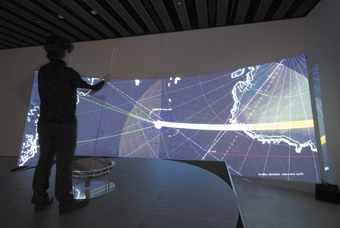
Norimichi Hirakawa, Global Bearing
In 2006 Experimenta Media Arts collaborated with the Sendai Mediatheque to offer Australian and Japanese artists a two-month residency at Sendai, in the Miyagi Prefecture. Curated by Kent Shimizu, the resulting exhibition reveals a diverse range of dynamic new media art that imagines Sendai at the centre of a matrix of local, national and global networks.
The Re:search exhibition is a hybrid of the traditionally lit and hung ‘white cube’ gallery with the darkened environment of the participatory ‘black box’ experience conventionally used to exhibit innovations in science. Re:search displays art created from materials including moving and still images, digital and analogue sound, maps, global positioning devices, satellite images and black and white, low definition footage seemingly from closed circuit television cameras. Themes that emerge include: the fracturing of identity, the escalation of paranoia and alienation within surveillance cultures and the potential for deception within commodity driven societies. Such themes are explored in relation to Sendai, Japan, Australia, the planet and some even extend into the universe.
Re:search opens with Norimichi Hirakawa’s Global Bearing, a large concave screen, upon which is projected a satellite map of the globe, complete with meridian lines. Global Bearing prioritises the Sendai Mediatheque by placing it at the centre of the map and measuring the distance between it and the rest of the world. The curved screen extends beyond the limits of peripheral vision, and the participant is invited to navigate the globe using what seems to be an oversized joystick. Travel is initially deceptively simple, but it becomes more difficult as the map begins to spin and flip. The participant is challenged to control the direction, speed and stability of the virtual map. Whilst this might suggest the difficulty of travel, or possibly the dislocation between virtual and physical spaces, more likely Global Bearing is a reminder of the inability of humans to control their environments.
In Conversations, Intimate moments with random strangers, Alex Davies explores the dual impulse of connection and alienation in an environment of dislocation and surveillance. Communication is at the centre of this exhibit, but Conversations is less about verbal discourse and more focused on investigating the possibility of connection through the eyes of anonymous people. Individuals are singled out from a crowd as they glance towards the camera/viewer. In elongating the duration of the moments of visual connection, Conversations seems to promise imminent contact. But because these intimate moments are fleeting and finally fail, ultimately this exhibit emphasizes unrequited desire. A similar illusion of proximity and imminence through the manipulation of spatial and temporal elements continues in Davies’ second exhibit, Swarm. Here he includes the visitor within the exhibit as a horizontal screen extends to reveal composite footage of visitors to the gallery, past and present.
Craig Walsh’s Big in Japan exhibits the artist himself inflated to a huge scale, towering over the city on a billboard. Big in Japan constructs levels of deception, obviously in the reversal of the dynamics of scale between the human and the metropolis, but also by employing a model to portray the image of the artist. The work questions the position of art within commodity-driven cultures, engaging the eccentricities of advertising. On opening night, Walsh employed female models to hand out tissue packets emblazoned with the billboard image. Across two adjacent screens, Walsh produces what appears to be closed circuit imagery (complete with time codes) as hidden cameras record locations within Sendai. Initially disquieting in its invitation to voyeurism, closer examination reveals that the low definition footage is carefully constructed.
<img src="http://www.realtime.org.au/wp-content/uploads/art/3/385_haslem_experimenta.jpg" alt="David Haines & Joyce Hinterding, Electromagnetique Composition for Building,
Plants & Stars (2006)”>
David Haines & Joyce Hinterding, Electromagnetique Composition for Building,
Plants & Stars (2006)
photo Michael Myers
David Haines & Joyce Hinterding, Electromagnetique Composition for Building,
Plants & Stars (2006)
Another outstanding exhibit is the David Haines and Joyce Hinterding collaboration in the production of Electromagnetique Composition for Building, Plants & Stars. Haines-Hinterding’s imagery of vivid green, lush, overgrown foliage slightly swaying in the breeze is juxtaposed with a soundscape comprising low frequency noise from within the Mediatheque, extending to an 18 kilometre radius of Sendai and including sounds emanating from the Milky Way. The soundscape is picked up on the copper wire antenna that spirals around the vertical rods of Mediatheque’s architecture. Image and sound combine to produce compelling links between the immediate space, the local city and the universe. The incredible beauty and simplicity of the imagery and the surprising range of the soundscape results in a sublime imagining of nature and science.
Also using soundwaves to great effect, The Sine Wave Orchestra’s contribution, Compath, a participatory sound project, relies on the user to create their own sine wave as a form of communication, each wave merging with others to create a collective soundscape. Employing fader levels, Compath appears to use old technologies to create distinctive effects. The emerging sounds are unique due to the range of options available to the participant.
The magic of Lieko Shiga’s photographs is created using manual techniques in re-photographing and printing. The Golden Mirage series was produced during her residency in Brisbane earlier in 2006 and it reveals a fascination with the impact of the elements on Australian landscapes and inhabitants. Iconic images of backyard bonfires and weathered faces of Australian men stand out in a range of dreamlike portraits of humans situated within surreal landscapes. Space is crucial to Shiga’s photographs and some locations work to suggest alienated inhabitants. In one of the untitled photographs from this series, the emptiness of a restaurant represents little help for a woman who sits at a large table, the blur of her head suggesting that she is suffering a seizure. Bizarre, paranoia-fuelled nightmarish compositions combine with a luminescent aesthetic to create images that are compelling and beautiful.
The Veil series of haunting and evocative photographs was produced during Shiga’s residency at Sendai. It constructs eccentric images of Sendai at night. A fluorescent pink shed in a backyard appears disconcerting not only in the vivacity of its colour but the darkness beneath the building also offers an impression of levitation. In another evocative landscape, Shiga attached cotton buds to a dead tree producing a stunning, luminescent image of revitalization within an arid landscape. In an eerie domestic scene, a light hanging above a ransacked lounge room seems to have sucked up any sign of life, only the whirlwind fragments of detritus remain. One of the most poetic images of desire and dislocation is the visualisation of the dream as an incarnation of a woman floating above a sleeping man, suspended by invisible forces.
The Sendai Mediatheque is an appropriate site for the Re:search exhibition. Designed by Toyo Ito, the mediatheque’s glass façade (or skin) acts simultaneously as an invitation to enter and as a reflection of its surroundings. Each level is linked by shafts of light that connect and illuminate the spaces. These shafts also house 13 vertical steel lattice tubular columns that appear like tree trunks rising from the ground floor to the rooftop. The mediatheque features archives, reading spaces, as well as a permanent display of the work of local artists. Intertwining the local with the global, nature with science, the Sendai Mediatheque is the perfect host for such an exhibition of visionary and creative new media art.
Re:search: an art collaboration between Australia and Japan, Sendai Mediatheque, curator Kent Shimizu, in collaboration with Experimenta, 2006 Australia-Japan Year of Exchange; Tokyo, Nov 25-Dec 25, 2006
RealTime issue #77 Feb-March 2007 pg. 30
© Wendy Haslem; for permission to reproduce apply to realtime@realtimearts.net
FEMINISTS HAVE LONG BEEN CONSUMED BY THE RELATIONSHIP BETWEEN GENDER AND TECHNOLOGY. WITH THE BIRTH AND RISE OF SUCH GIBSONESQUE “CONSENSUAL HALLUCINATIONS” AS CYBERSPACE, IT WAS FEMINISTS SUCH AS DONNA HARAWAY, SADIE PLANT, LISA NAKAMURA AND ALLUCQUÉRE ROSANNA STONE WHO SOUGHT TO ARTICULATE THE REPLICATION OF OFFLINE INEQUALITIES ONLINE. IN AUSTRALIA, THE BEGINNINGS OF NEW MEDIA WERE STRONGLY TIED TO ADDRESSING THESE CONCERNS AS EPITOMISED BY THE WORK OF VNS MATRIX.
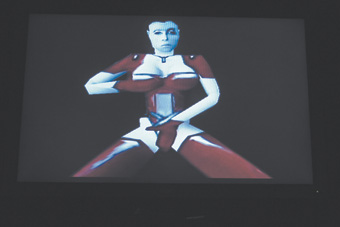
Tobias Berstrup, Polygon Lover
Extending the feminist agenda, new media theorists and practitioners began to consider how language and ethnicity shape the experience of technology and their impact on offline relations. In the ‘global’ world of the internet we can see that the dominance of English is quickly being contested by the increasing appearance of Chinese, Spanish, Japanese and Korean sites. The ‘local’ is contesting an homogenised ideal of globalisation. Negotiating the local—establishing co-presences, virtual and actual—is particularly prevalent in online gaming communities in what TL Taylor dubs “play between worlds” (Play Between Worlds: Exploring Online Game Culture, MIT Press, 2006).
So how can we think of gendered ideas of technology in a period where gender is but one of many complex and competing factors influencing our relationship to technology? With this question in mind I ventured along to Teknikunst. Curated by dynamic duo Kristen Condon and Lynsey Hagen, this year’s exhibition took as its title Condon’s neologism, “GenderTopia.”
The impressive line up of artists included Josephine Starrs (co-founder of VNS Matrix), Melinda Rackham, Linda Dement, Cynthia Verspaget (in collaboration with Adam Fiannaca), Rosie X, Michelle Siciliano, Oliver Ressler (Vienna), Jose Carlos Casado (New York) and Tobias Bernstrup (Sweden). Whilst some of the individual works were compelling, others sat together uncomfortably, like two people shouting (in different languages) over each other. Moreover, some of the works were not great examples of the artist’s oeuvre. In Josephine Starrs’ video, Pocket Calculator, the artist innanely sings a karaoke-style version of a Kraftwerk song accompanied by stereotypical images of Tokyo. Any lo-tech vs hi-tech irony in the work was overshadowed by a suggestion of techno-orientalism (the Asian city exoticised as techno-centre) highlighting a notable lack of Asian new media artists in the exhibition.
In Armour, Rosie X (with Técha Noble, Laura Jordan and Wade Marynowsky) presents us with a series of scenarios navigated by a protagonist geekgirl. The intentionally naff flash animation explores the paranoia around the Y2K millennium hype (remember that?). But as one visitor proclaimed, “wow, that’s sooooo last century”, the problem was that this work—made in 2000—was not aptly contextualised as a comment on an historical moment. It just looked dated. The effect was exaggerated by its being placed next to a sociological, documentary style video work, Die Rote Zora, by Oliver Ressler. Made in 1998, this work documented the militant women’s group, Rote Zora’s 20 attacks against “patriarchical orders” such as the companies of Bayer, Schering and Siemens. The disparate themes and styles of the two works made their conjunction beneath the gender and technology banner unrevealing.
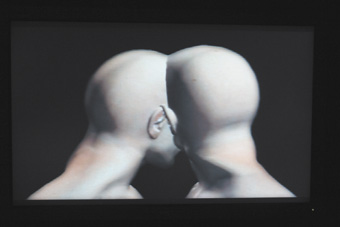
Jose Carlos Casado, Inside V.O4
Other exhibits added weight and currency to each other. Two 3D animations, Polygon Lover by Tobias Berstrup and Inside V.04 by Jose Carlos Casado, worked well together in their exploration of and play with body politics. Berstrup has the SiN game female character Elexis masturbating. Evocative of the style of game artist Brody Condon, Berstrup’s work suggests that gaming is still very much in need of feminist interrogation. Neighbouring this explicit work we find its inverse in Casado’s sublime metamorphosis of androgynous heads as they fuse, blur and transform into abstract forms. This poetic account of the ambiguities of identity and indivisibility is kin to the work of Chris Cunningham (particularly his music videos for Bjork’s All Is Full Of Love).
Morphing is also used in Claudia Hart’s beautiful Machinia. Based loosely on Titian’s Venus this beautiful nude isn’t a still life. She moves and she looks, slowly inverting the tradition of the male gaze. The title is a play on the growing genre of “machimina” (a neology encompassing machine and cinema) whereby game artists make self-reflexive and hyper-conscious mini-films of games that question ideas of interactivity, digital storytelling, game play and the politics of simulation. Machinia succinctly demonstrates how such disciplines as gaming owe much to cinema and the visual arts, but in other ways are emerging as media with their own specificities. In this way, Hart’s work is not only in dialogue with Casado’s fusion of the real and the reel, realism and abstraction, but also elaborates on Berstrup’s deconstruction of gender gaming stereotypes.
GenderTopia was an undulating ride, from wonderfully poetic and compelling works to questionable selections of exhibits without contextualisation. Works exploring issues around gaming and online-offline co-presence were the most compelling in respect of the theme. But why were there no artists from Asia given the plentitude in the region exploring Teknikunst’s theme? Beyond this oversight, GenderTopia highlighted gender and technology issues as ever pervasive, and reminded us that realms such as gaming are still in need of critique. Game on, feminist? Wii, Wii (Nintendo).
Teknikunst 06, GenderTopia group exhibition, Meat Market Main Hall, Melbourne, Dec 9-17, 2006; www.teknikunst.com
RealTime issue #77 Feb-March 2007 pg.
© Larissa Hjorth; for permission to reproduce apply to realtime@realtimearts.net
“IN THE FUTURE, SALLOW YOUTH WAIT LISTLESSLY FOR TRAMS THAT NEVER COME. THEIR SKIN GLOWS GREY DESPITE DARKENED SKIES AND BILLOWING RAINLESS CLOUDS…SCARRED, RAVAGED, TRAUMATIZED—YET STRANGELY INNOCENT—THESE YOUTHS APPEAR TO HAVE STEPPED STRAIGHT OUT OF A BOMBED HOSPITAL WARD. IN THE POST-FUTURE, THEY LINGER STILL—SHIMMERING GHOSTS OF THE AUSTRALIA THAT NEVER CAME” [NORTHERN VOID PRESS RELEASE].
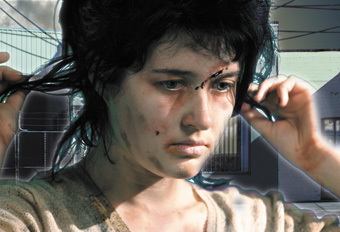
Thembi Soddell, Northern Void
photo Pancho Calladetti
Thembi Soddell, Northern Void
The genesis of Northern Void has been a haphazard series of events. Ph2 (Philip Samartzis and myself) were developing a piece for the Podewil Centre in Berlin some years back. Following changes in administration there, the funding for the project was then to be secured through a different body—one that was seeking projects which addressed site-specific and culturally dependent issues concerning the city of Berlin.
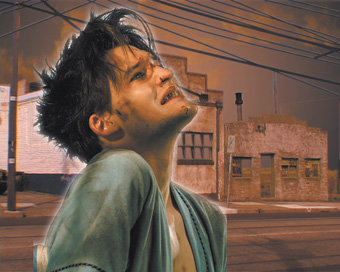
Nigel Brown, Northern Void
photo Pancho Calladetti
Nigel Brown, Northern Void
Initially I was quite deflated by this change. I have no connection to the idea that artists should be responsible to anything—their setting, their audience, their past, their new zones of activity. The idea that artists can somehow magically enter a new cultural domain and—purely through the suggestive power of curatorial legislation—be deemed not merely responsible but also capable of addressing anything is simplistic. I view the prime value of artists being their disconnection from society, through which energy lines and points of impact can eventuate, but not solely through an artist claiming he or she is ‘addressing/exploring/investigating’ some topical issue of the world. Like, that’s so Ben Elton meets the Venice Biennale.
But then I thought, okay, if Berlin wants me to ‘address the city’, then I’ll do just that. So I devised a story set across both World Wars, involving gas, prosthetics, skin, celluloid, dolls, corpses, music, bombs and movie theatres. I was going to film all the locations there, then get actors in a green-screen studio back in Melbourne to act out the narrative, then I’d composite it all together.
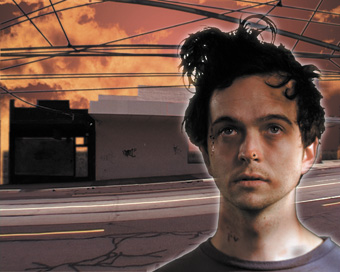
Gus Franklin, Northern Void
photo Pancho Calladetti
Gus Franklin, Northern Void
The Podewil project fell through, but actually I was liberated by this in two ways. Firstly, I felt enabled to devise any narrative/visual situation to which Ph2 could then work a live score. Secondly, I realized that I could address topical issues—but purely on my own terms, even if it be to my own detriment. My work generally deals with the ideological but always via submerged and what I contend are more opaquely politicised strategies buffed to gleam with Pop-ist surfaces.
So, shortly after, Phil Samartzis secured for Ph2 a showing of a new audiovisual work in Moscow. The idea of travelling and somehow ‘representing Australia’ again was repellent—yet now exciting. I thought, okay, I’ll show what Australia is like from my view. Not only that, I’ll predict what it will become.
Specifically, the idea of utilising science fiction for this purpose excited me. Science fiction is now exciting because it is the most bankrupt mythological narrative vehicle imaginable. When everyone from Hollywood to my mum can devise a dystopian scenario that champions rebels, critiques corporations, celebrates the hero’s journey and believes in humanity, then the form isn’t even worth subverting. My view of the future is a simple one: you’re soaking in it. In an era that commodifies the very notion of evolution as a sales strategy for iPods, then you know that humankind has reached a dead end that can only progress through complete decimation. But hey, that’s just my opinion. I’m sure breeders have great things in mind for the future of their children.
In this sense, Northern Void wonders what the future might be like in ways devoid of both grand narrative and social critique mythologies (both of which are equally suspect in their murky muddling of humanism and universalism). So I picked not some towering metropolis, but simply a three kilometre strip of shops and factories in Plenty Road, Preston—an outer northern Melbourne suburb.
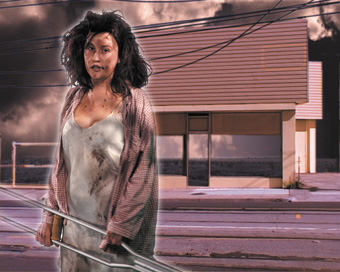
Madeline Hodge, Northern Void
photo Pancho Calladetti
Madeline Hodge, Northern Void
I hadn’t visited this area for many years (it’s near where I grew up) and I was shocked by how desolate it had become. Not an ‘aesthetic’ kind of Ed Ruscha desolate, just a real ‘present-tense’ banality that is old but locked in a frozen time period. Plenty Road is a mix of cheap 1970s brickwork and shrubbery with cheap 80s facades with cheap 90s computer-lettered signage. Failed small businesses delivering basic services in a saturated domain where nothing grows. Most importantly, this isn’t just Preston: this is a perfect snapshot of Australia. I’m very curious to see what the Russian response will be.
The video is a series of portraits of young people who have been made up to look ill—not spooky, just fucked-up and off-medication. I don’t drive, so I’m on public transport all the time, and really this is how I see most people. Things have developed this way as health services (especially mental health services) have been withering away over the last few decades. Plus the Plenty Road strip is a tram route, and public transport is another key service that has been utterly bankrupted in Melbourne. Like most of Australia, more work is now put into logo design and signage than an actual service.
A lateral inspiration for Northern Void comes from being in San Francisco in the early 80s and (long story for another time) spending a few nights in casualty at SF General Hospital. I was also struck by how many people were on crutches in the street—the more I realised this the more I saw. I remember thinking at the time that ultimately America is a vision of a future Australia. Some decades down the track now, I still relate to that perspective—not that Australia is somehow colonised by the US, but that Australia’s own de-evolving mechanisms have generated the state we’re now in.
Suffice to say that through the Northern Void project I’m optioning another way to consider things as they are, and working through another projection of this thing called Australia. Ultimately, it’s neither dystopian (because I think all utopias are deluded so there’s no point in opposing them) nor apocalyptic (because such a Judeo-Christian embrace of ‘finality’ is not part of my world view). Put simply, Northern Void is a suite of pastoral portraits which evidence the future as a slow drain. No eventfulness; no catharsis; no resolution. Just lots of young people getting sick too quickly, waiting for public transport that will never come. If change is required to forestall this, it will not come from obvious strategic measures. These symptoms need to be read devoid of the possibility of cure in order to perceive their status with clarity. Such is the audiovisual aim of Northern Void.
Northern Void will be performed live by Ph2 in multi-channel surround.
The video is divided into 3 sections: The Present (2013), The Future (2085) and The Post-Future (3079).
Spatial Drift presents Northern Void, director Philip Brophy, score performed by Ph2 (Philip Brophy, Philip Samartzis); Australian Centre for the Moving Image, Melbourne, Feb 17, 18, www.acmi.net.au, www.philipbrophy.com
RealTime issue #77 Feb-March 2007 pg. 28
© Philip Brophy; for permission to reproduce apply to realtime@realtimearts.net
IN A SANDSTONE BUILDING OVERLOOKING A PARK IN FREMANTLE, ATTENDEES TO AN INTERNATIONAL CONFERENCE SAT STARING, GIGGLING AND FROWNING AT PROJECTIONS OF VIRTUAL LANDSCAPES, PHOTOS, QUOTES AND STATISTICS. THE EVENT WAS A SPECIAL JOINT CONFERENCE BETWEEN CYBERGAMES: INTERNATIONAL CONFERENCE AND EXHIBITION ON GAMES RESEARCH AND DEVELOPMENT, AND INTERACTIVE ENTERTAINMENT 2006: THE THIRD AUSTRALASIAN CONFERENCE ON INTERACTIVE ENTERTAINMENT.
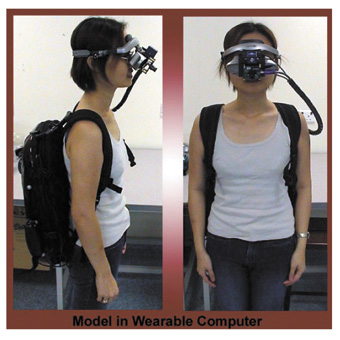
Model in wearable computer, Human Pacman (2005) Mixed Reality Lab, Singapore
Rest assured, participants did go outside and feel the sun on their cheeks, but the chuckling of children playing in the park was no subsitute for the serious study of how people of all ages play in the digital realm. Yusuf Pisan, Technical Chair and Founder of Interactive Entertainment (IE) outlined in the proceedings the motivation behind the conferences:
The interactive entertainment industry continues to grow at a rapid pace worldwide. This expansion needs to be examined not just in dollar amounts they contribute to the economy or the number of people playing computer games, but also in how our everyday interaction is changed and shaped by this new medium. We are defining not just a new field, but a new way of being.
The champions of our evolution are a mix of Australian and international practitioners and researchers from the fields of Artificial Intelligence, Media Studies, Human Computer Interaction, Design, Graphics, Cultural Studies and Psychology. We’ll start with industry. Elina MI Koivisto of Nokia Research gave one of the two keynotes on the “Vision of the Future of Mobile Games.” Nokia is attempting to move mobile gaming beyond the current approach of remediating familiar games like Pacman and Tetris. The company is exploring how the mobile, a device that is always with you and always connected, can facilitate the persistence of game worlds. For instance, they’ve published a cross-platform, massively multiplayer online role-playing game that you can play through your PC and phone: HinterWars: Aterian Invasion (Activate, 2005). Nokia are also looking at the way we interact with these game worlds by exploring applications that allow different input and feedback systems like game pads and motion bands.
Likewise looking at game world persistence and how to produce different ways of interacting is the Mixed Reality Lab in Singapore (www.mixedrealitylab.org). Adrian David Cheok provided lots of photos and descriptions of projects in his talk on “Social and Physical Interactive Paradigms for Mixed Reality Entertainment.” Mixed Reality Lab has created many games that are set in the real world but your actions impact on a virtual world. For example, Human Pacman (2006) involves a person donning a wearable computer and walking down the street. As you walk you devour cookies in the virtual world. Cheok also outlined a few projects that involve playing with your pet. For example, you can play chasey in a virtual world with your real life pet hamster in Metazoa Ludens (2006) or you can pat your hen remotely with Poultry Internet (2004). The lab is also interested in bringing elderly people and children together: Age Invaders (2006) has grandparent and grandchild shooting each other on a dance-floor-like setting with virtual ramifications.
Concerned with how elders (or teachers) can guide young people, Scot Osterweil, Project Manager for MIT’s Education Arcade (www.educationarcade.org), gave a passionate and canny talk on what he terms “learning games.” Games can be used for teaching but many extant ones, he explained, fail because of poor design. Many are created, for instance, with a “content stuffer” approach: they use an existing game platform and inject it with education related content. The result, he jokes, is “Grand Theft Calculus.” Osterweil makes the point that “without playfulness, a game is just going through the motions.’ As a guide, he juxtaposes four freedoms that he believes are the same for play and learning (outside of school): freedom to experiment, freedom to fail, freedom to try on identities and freedom of effort. Arguing that all game play is about learning, Craig A Lindley of Gotland University, Sweden, in “Game Play Schemas: From Player Analysis to Adaptive Game Mechanics”, divides what is learnt into three forms: interaction mechanics (how to interact with the machine), interaction semantics (associative mappings of that interaction) and game play competence (how to progress through the game).
There were five special sessions, the standout of those that I attended was “Experiential Spatiality in Games: Knowing Your Place.” Chaired by Nicola J Bidwell of James Cook University, it included a holistic selection of speakers exploring place, immersion and self. Ulf Wihelmsson of the University of Skövde, Sweden spoke about what he terms the “game ego”: “a bodily based function that enacts a point of being with the game environment through a tactile motor/kinesthetic link.” Wihelmsson argued that the game environment affects a person’s game ego through constraints on what they can do. Andrew Hutchison of Perths’ Curtin University explored how game graphics remove parts of our avatars. He entertained us with examples from games like Half-Life 2 (Valve Software, 2004) where your hand disappears when picking up objects, but is always present when holding weapons; and Doom 3 (id Software, 2004), a game with an extreme graphics engine that performs an array of blood-splatter and shooting effects, but doesn’t give us legs.
Although some games do give us legs, David Browning of James Cook University argued they don’t give us realistic interaction with the terrain. You cannot, for instance, get your feet stuck in mud. Games that are designed for proprioceptivity (using many senses to experience the weather etc) will engage players in the game world more. Georgia Leigh McGregor of the University of New South Wales, focused on the architecture of game worlds comparing World of Warcraft (Blizzard Entertainment, 2004) and Lord of the Rings: Battle for Middle Earth II (Electronic Arts, 2006) and finding that architecture in the former is designed as a spatial experience. The latter, however, treats architecture as an object that cannot be entered and explored. Truna (aka Jane Turner) gave a demonstration of a virtual world that was created to explore archives of the real world. The Australasian CRC for Interaction Design’s Digital Songlines (2005) project (songlines.interactiondesign. com.au) is a virtual landscape of Australia that you can traverse. Your presence in an area triggers local stories, providing a spatial navigation analogous to the manner the stories are recorded traditionally in Indigenous cultures. In her paper, “Digital Songlines Environment”, Truna expands on the culturally-aware design:
The design goal of this project is to reconstruct the Indigenous experience from an Indigenous perspective rather than the usual cultural archiving which tends to prioritise the needs of the database structure and meta-data tags and fields.
Two post-conference workshops, run by Scot Osterweil and myself, provided a more intensive insight into how to design experiences that address audiences rather than system architecture. Overall this first joint conference, chaired by Kevin Wong, Lance Fung and Peter Cole, was a thoroughly enjoyable experience. It was good to have such a cross-fertilisation of topics (only some of them covered here) and to have the chance to debate at length with delegates from around the globe. We didn’t solve what “new being” interactivity is birthing, but had fun in the kindergarten of its evolution.
CyberGames: International Conference and Exhibition on Games Research and Development, and Interactive Entertainment 2006: The Third Australasian Conference on Interactive Entertainment, Fremantle, Dec 4-6, 2006
RealTime issue #77 Feb-March 2007 pg. 29
© Christy Dena; for permission to reproduce apply to realtime@realtimearts.net
TECHNOLOGIES OF MAGIC BEGINS WITH A SIMPLE YET INTRIGUING QUESTION: “WHY IS IT THAT MANY TECHNOLOGIES, PARTICULARLY MEDIA TECHNOLOGIES, CONTINUE TO BE SHROUDED IN A MYSTIQUE, PRESERVING FORMS OF MAGICAL BELIEF WITHIN RATIONALLY ORDERED SOCIETIES?”
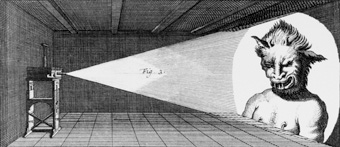 Lantern of Fear, Gulielmo Jacobo ’s Gravesande,
Lantern of Fear, Gulielmo Jacobo ’s Gravesande,
Physices Elementa Mathematica, Geneva, 1748, from Eyes, Lies & Illusions, ACMI
Advertising has long been a site for such expressions represented in, for example, Bell’s 1915 “weavers of speech” advertisement depicting an operator working “upon the magic looms of the Bell System” to weave “millions of messages into a marvellous fabric.” Or consider the 1950s “Spellbound” campaign from American company Ampex, promising users of its new audio system “an exquisite pleasure and a dangerous revelation.” More recently, figures of enchantment appear throughout the advertising of Motorola, Sony and Nokia (Sony’s 1990s “Magic Link” PDA, as just one example; advertisements cited are available at: www.adflip.com). And for its unfettered celebration of technology’s sublime power, it’s hard to ignore how Time magazine announced its front cover 2006 Person of the Year through that uber media of illusion and fantasy: the mirror.
This edited collection is a valuable addition to research examining the material and symbolic interconnections between magic and technology or what John Potts calls “media mysticism.” Although the contributors deal with practices of magic in diverse ways, the editors outline a common definition: “the key notion is the kind of performativity which arises from an agent of transformation whose effects are evident but whose operations are not apparent.” For Andrew Murphie, in his elegant chapter, “‘Brain-magic’: figures of the brain, technology and magic”, transformation and performance are crucial for understanding how power links the cultural fields of magic and technology: “magic has always been about power—over life and death and illness, over transformation, over appearance and disappearance…this is what technology is increasingly about as well.” Rather than viewing the cultural logic of magic as antithetical to science, Murphie explores the “indissoluble binding between magic and technology.”
The paradoxical yet symbiotic relation between magic and technology is a central preoccupation of the book. In her chapter on “the modest witness”, Anne Cranny-Francis revisits Donna Haraway’s work on the disinterested observer within scientific discovery. Cranny-Francis recounts a compelling ‘urban-legendesque’ story of two women who, while driving at night, encounter a threatening ghostly vision manifesting as a tailgating motor bike audible within their car and clearly visible through their rear vision mirror. However, when the passenger rolls down her window to remonstrate with the motorcyclist the vehicle ‘disappears’ to return only when the two glance back through their mirror. What’s interesting for Cranny-Francis is the subsequent discussion in which the passenger, a science PhD candidate, denies having had the experience. As a scientist, the woman refuses to believe in anything that is not explicable through logical and rational means. The driver then suggests that “perhaps science simply does not know yet how to describe such a phenomenon” to which the scientist replies “no, I simply do not accept what I saw; I did not see it.” This story illustrates the inherent ideological tensions of the objective observer. The scientist, argues Cranny-Francis, “could not afford to be known as someone who believes in things that are outside mainstream scientific thought. If she is positioned outside that mainstream, she will not be acceptable as a modest witness and so will be unacceptable as a scientist.”
Also exploring the unacknowledged ‘bridging’ of mysticism and science, are John Potts’ contribution on the contemporary ghost and Chris Chesher’s piece about the function of invocation within technological practice. For Potts, ghost discourse—including “academic parasychological research initiatives”, anecdotal reports from ghost hunters, and web sites selling ‘ghost detectors’—demonstrates the persistence “of mystical belief in societies founded on rationalist principles.” Modernity, he suggests, has never been fully “disenchanted” since “enchantment”, understood as a form of “belief in the supernatural”, continues to flourish “even in highly technologised cultures.” Arguing for the enchantment of Western modernity, Potts joins writers such as Simon During (Modern Enchantments: The Cultural Power of Secular Magic, Cambridge, Harvard, 2002) and Alex Owen (The Place of Enchantment: British Occultism and the Culture of the Modern, University of Chicago Press, Chicago, 2004). In his chapter on “The Muse and the Electronic Invocator”, Chesher develops his theory of the invocation. This “cultural form” he explains is “a call to a power outside ordinary fields of perception and action for immediate assistance, guidance or support.” The invocation operates through a diverse range of institutional and technological settings: “magicians invoke spirits; priests invoke the name of Christ; artists invoke a Muse”; and “a computer program invokes a subroutine.” Although careful to distinguish between these divergent socio-technical fields, Chesher argues that the “remarkable regularity” with which the invocation appears “undermines the myth” that there exist “complete revolutions in human affairs.”
For some contributors, the “strange borderland” between rationality and mysticism is underpinned by “the technological uncanny”: those voices, histories and practices that are rendered unfamiliar by powers articulated through specific economic and political registers. Scott McQuire, for example, traces elements of Freud’s theory of the uncanny, where “inanimate objects seem to come to life” within the development of spectacular electrical illumination. In particular, McQuire explains how “the fundamental spatial ambivalence of electrification” enables new architectural forms and urban configurations in which “architecture seems to come alive.” Similarly, Annette Hamilton discovers uncanny relations operating between “humans and their things.” While “our discarded objects mock us in the garbage dumps of the world”, new technologies promise the opportunity to develop a “more care-full and respectful” structure of ethics. And in Stephen Muecke’s astute critique of the ethnographic ahistorical address, situated voices of the ethnographic subject are repressed. In response, Muecke calls for a “new ethnographic practice” that rejects “the positivism of an anthropological practice which constructs another society as unified ‘over there’… in which ‘they’ remain superstitious, about, say, an eclipse of the sun while ‘I’ am necessarily beyond that historical stage.”
Technologies of Magic is both timely and historical: cogent in its contemporary observations and historically enchanting.
John Potts and Edward Scheer eds, Technologies of Magic: A cultural study of ghosts, machines and the uncanny Sydney: Power Publications, 2006. Available through Power Publications (www.arts.usyd.edu.au/departs/arthistory/power) or Gleebooks (www.gleebooks.com.au).
RealTime issue #77 Feb-March 2007 pg. 31
© Esther Milne; for permission to reproduce apply to realtime@realtimearts.net
WHILE INTERACTION IS PERHAPS THE MOST BASIC THING THAT CAN OCCUR WITHIN ANY CONTEXT, FORMING THE RAW BASIS FOR ALL COMMUNICATION IN BIOLOGY AND SOCIALITY, INTERACTIVE ART IS FAST BECOMING SOPHISTICATED AND REFLECTIVE.
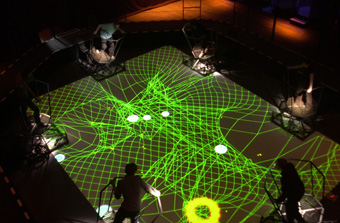
Time’s Up, Graviton
Artists whose practice includes works that are interactive have begun exploring the audience experience by investigating the extent to which their works engage an audience in an interesting and satisfying ‘conversation’ with the work’s content through the details of its sensing and responsive character. This notion of engagement is similar to the notion of immersion, though without the connotation of floating in some private pool of virtual space or information.
The Engage symposium at University of Technology Sydney provided a venue for artists whose works incorporate interactivity, to focus their attention on questions of how well interactive works achieve their aims and how that can be measured. The symposium followed two interwoven lines: the discussion of works that are engaging in their interactive behaviour and the discussion of methods for discovering what it is about these works and the audience’s experience that makes them engaging. Thus interactive art has developed two contexts: one as art in which the nature of the experience, the content, the intentions and discussion that the artist wants to bring to attention become the issue; and the other as science, where the study of the interactive mechanisms and their capacity to entice involvement or engagement lead toward a theory of effective design. This scientific interest in the character of engagement itself involves two further stages: the mapping of gestural and other audience behaviours into the processing systems that lie behind interactive art installations, and measuring the success with which that mapping is handled so that the person participating in the installation becomes engaged with the work.
Overall the question becomes: how do artists make interactive works that people enjoy engaging with, given that, as Mike Stubbs (media artist and Exhibitions Program Manager, ACMI) argued, engagement is more interesting when it is not simply a function of some technical characteristic of the particular devices being used, but is primarily content oriented.
Participation implies a relinquishing of curatorial and artistic control. British curator Beryl Graham illustrated this with Rafael Lozano Hemmer’s installation Body Movies: Relational Architecture 6 (Rotterdam, 2001). This was a large-scale public light-projection work in which people interact through differences in the scale of their shadows on the walls of a building. It is the spontaneous interaction of the audience that makes the work effective. Tim Boykett, of the Austrian group Time’s Up, spoke about how they approached this problem in their installation, Hyperfitness Studio, in which they present the audience with intuitive interfaces utilising the metaphor of the fitness and sporting facility. The audience are put in the position of “proto-scientist” and have to make sense of what they find and, Boykett observed, they appear to enjoy having to experiment in order to make the connections.
Our engagement with the work also comes through being represented within it, and the more so when in intriguing and mysterious ways. As Kathy Cleland (writer, curator, lecturer, University of Sydney) noted in referring to several early video installation works (fortuitously available in the Centre Pompidou collection currently at the MCA and soon at ACMI), we do enjoy seeing ourselves in the artwork, especially when one’s image appears to be acting in ways that are quite contrary to one’s current behaviour. This is something that also arises in more recent work such as Alex Davies’ Dislocations, where virtual characters irrupt into the viewing space causing a curious dissonance within the audience’s experience. Davies’ paper subsequently revealed some of the technicalities of these illusions.
Mari Velonaki looked at another aspect of the projected personality within the installation. In her work, including her Fish-Bird’s roboticised wheelchairs we enter a “conversation” with characters who respond, often quite obliquely, to our presence thus drawing us in as participants. In Velonaki’s installations the technology is hidden, producing an illusionistic space similar to the cinema, allowing the suspension of disbelief and easing identification, but this illusion and the potential engagement can be easily broken if the projected personality responds in baffling ways.
Other problems that disrupt the illusion are more technical. For example, Nick Mariette has been exploring the Audio Nomad system (based on work by Nigel Helyer). Sound is superimposed on objects in the gallery or public space and the question becomes how well the received sound relate to the visual sites upon which it is superimposed; ie how good is the tracking and the sound rendering for source position fidelity. Here the science enters; Mariette is involved in experimental work in psychoacoustics within virtual sound environments.
With the many ways in which the audience’s presence within an installation and their responses to it can modulate its behaviour, a new kind of aura becomes attached to interactive art, of behavioural presence which, if there is going to be any kind of engagement, asks that the installation be able to actually sense aspects of the audience’s behaviour. Conversation being two-way, not only does the installation need information about its interlocutor but also that person needs to be having an experience that makes it clear that the installation has some knowledge of their presence. This leads to the investigation and evaluation of the user’s experience.
Ultimately the question must be: is the experience effective, interesting, stimulating, exciting, provocative and thus engaging? This is largely a qualitative inquiry using the methods of cognitive science. These mostly comprise various forms of post-experience interviews, often videotaped for subsequent analysis, building up categories of behaviours and personal impressions that bring out the audience’s actions, perceptions, circumstances and reflections on the experience. Some work on analysing recordings of the audience’s actual behaviour is also done.
One of the more interesting situations in which the investigation of interactive art is occurring is Beta_space, a dedicated interactive venue jointly established by the Creativity and Cognition Studios (CCS) group at the museum. Beta_space is an environment where artists can evaluate new interactive artworks using these observational and interview procedures with audience members who are willing to describe their experiences in the artwork. It also provides a context in which researchers can test and evaluate protocols for exploring user experience for use in the refinement of design processes (RT76).
There is an underlying question of what it is exactly that new media art sees itself as doing. Obviously this varies from artist to artist. Is it making new subjectivities, increasing curiosity by providing questions or conundrums for people to investigate, exploring and critiquing new technologies, offering mysteries and moments of wonder that can come from spending time with a work and engaging with it? Is it exploringour relationship to technology with a view to developing new interactive technologies for media use in general? Or are the interactive arts to be reduced to some sort of bread and circuses entertainment? We must remain aware of this potential and lift ourselves out of it into a more politically and socially cognisant activity where the exploration is of ideas and the stimulus is more than just momentary. As Lyndal Jones pointed out, it is not “interactivity per se that is important but [the] generation of meaning through the work…Furthermore…the resulting work needs to have creative and/or social impact.” This is the sort of engagement that I seek.
Engage: Interaction, Art & Audience Experience, a symposium presented by the UTS Creativity and Cognition Studios (CCS), ACID ( Australasian CRC for Interaction Design) and ANAT (Australian Network for Art & Technology); University of Technology Sydney, Nov 27-29, 2006
RealTime issue #77 Feb-March 2007 pg. 32
© Stephen Jones; for permission to reproduce apply to realtime@realtimearts.net
KURT VONNEGUT ONCE HYPOTHESIZED A HOLOCAUST IN WHICH THE CHEMICAL BONDS OF THE WORLD’S WATER SUPPLY PERMANENTLY FUSED FOLLOWING THE ACCIDENTAL RELEASE OF A LETHAL CHEMICAL REFERRED TO AS ICE-9. THE WRITER USED THE CATALYTIC PROPERTIES OF THE CHEMICAL AND THE FLUID DYNAMICS OF WATER TO CONVEY A SENSE OF THE INTERCONNECTEDNESS OF SYSTEMS.
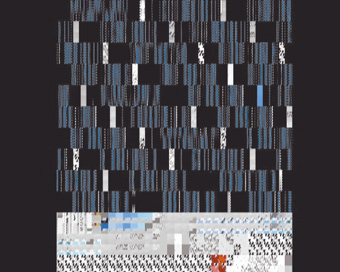
Tracey Cornish, Glitch
An ostensibly discrete puddle becomes infected with the chemical and connects with the muck and ooze of the surrounding swamp, breaking out into deltas, rivers, oceans and clouds, and permeating the cell walls of almost every living thing on the planet.
This notion of complex interactions has been adroitly summarised by American sociologist and philosopher Theodore Nelson:
Intertwingularity is not generally acknowledged; people keep pretending they can make things deeply hierarchical, categorizable and sequential when they can’t. Everything is deeply intertwingled.
Intertwingularity at the EAF is an exhibition of computer-generated moving images created by Tracy Cornish, emerging from her doctoral research into generative photography and the non-linearity of complex systems. She refers to these works as found objects, artefacts that have arisen from computer translation errors and source glitches whilst encoding prior works.
Emission Glitches is a shifting mosaic of colour-soaked pixels, the result of a coding error whilst the artitst was putting together a moving image called Glowing Emissions. Glitches perforate the vacuum seal separating different kinds of media reality. There is a place between the gestalt of recognising a familiar pattern or code and relating it to the next in which the mind freefalls before finding something to hold onto, measure, record and customise. Watching the shuffling patterns in this work, it is tempting to want to lock down its content into something recognisable: as if this elusive pattern is simply the poor transmission of a known television program. Buddhist philosophy has for centuries recognised the benefit of placing the logical part of the mind into suspended animation. Zen koans such as the well travelled ‘sound of one hand clapping’ pose questions that are unanswerable and often circular in nature, generating experiences that would remain inaccessible via logical or sequential thinking. Cornish refers to complexity in her thesis as information containing more than one form of representation simultaneously, citing the ambiguous rabbit-duck illustration (first noted by the American psychologist Joseph Jastrow) as an example of how perception is a result of cognition, not simply an index of external stimulus.
The slip of gears between recorded stimulus and awareness is present in another of Cornish’s glitch pieces, Encoding Patterns. This sequence is the result of a slightly more complicated process involving the transposition of a photograph into sound using synthetic software. Accessible as an open-source application, this “visual prosthesis” software is used by the visually impaired as a means of accessing web content. Fundamentally, it operates by converting images into frequencies. The ensuing artefact is a waterfall of graphic striations with the odd hint of something familiar, such as road or a mirage of elongated people. This warp and weft of glitchy abstractions emits an aura of compression and absence simultaneously. Watching the cascade of information on screen is like watching the back of a scrolling tapestry, or a machine dreaming from the vantage point of its root directory.
The same software used to generate Encoding Patterns was also used to produce the exhibition’s soundscape, Sound Glitching. Cornish used the vision software to sample images from this sequence at a rate of one frame per second, converting these captured stills into sound files and arranging them into an accompanying score. It is uncanny how such procedures always seem to emulate a kind of neurological synesthesia.
Machine translation—whether as an interlocution between human languages, or software packages—exposes the difference between computational complexity and true Artificial Intelligence, which computer science is a long way from achieving. A toaster may be programmed with enough complexity to accommodate different tastes, but it will be a long time before machines understand that burnt toast tastes bad.
The works in Intertwingularity succeed collectively as an entry point into generative artforms and emerging media theory. However they are still at an experimental stage and not quite ready to support their own weight without an adjoining thesis. Technology sophisticates are much more likely to enjoy a richer aesthetic response to this work than viewers who know nothing about machine complexity. Of course as machine interfaces evolve to increasingly mirror human complexity, research into the cognitive and aesthetic experience of such interfaces becomes progressively more relevant.
Tracy Cornish, Interwingularity Experimental Art Foundation, Adelaide, Oct 6-Nov 4, 2006
RealTime issue #77 Feb-March 2007 pg. 33
© Samara Mitchell; for permission to reproduce apply to realtime@realtimearts.net
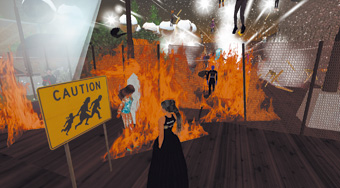
Second Life, photo Lythe Witte (Christy Dena)
THIS SCREEN SHOT IS OF A SITE-SPECIFIC PERFORMANCE HELD IN THE ONLINE VIRTUAL WORLD SECOND LIFE (SL).
The event was the opening of an installation by SL resident JC Fremont, an artist and academic who goes by the name John Craig Freeman in real life. In Imaging Place SL: US/Mexico Border, Fremont explores the notion of political and artistic borders with a two-part installation that includes a large border fence. Second Front (www.slfront.blogspot.com), apparently the first dedicated performance art group in SL, were commissioned by Ars Virtua Gallery (www.arsvirtua.com) curator Rubaiyat Shatner to create a performance for the opening held January 5, 2007. Second Front actors, attired as virtual helicopters and inspectors, cast all the guests at the opening as illegal immigrants and proceeded to interrogate and harass them. The drama escalated when Second Front showered the border with barricades and set the place on fire—some people in power think the only solution to dealing with border crossers is to blow them up. CD
RealTime issue #77 Feb-March 2007 pg. 29
© Christy Dena; for permission to reproduce apply to realtime@realtimearts.net

On perspective and motion (part 2) 2006, Daniel Crooks
IN A MEDIA CULTURE SATURATED WITH VISUAL SORCERY, IT IS NO MEAN FEAT THAT THE TIME SLICE PRACTICE OF DANIEL CROOKS CONTINUES TO ASTOUND. COMMISSIONED FOR THE BIENNIAL ANNE LANDA AWARD, ON PERSPECTIVE AND MOTION (PART 2) IS NO EXCEPTION, PUSHING THIS EXPLORATION TO A NEW LEVEL OF LYRICISM.
Distributed across seven screens Crooks has captured (with seven cameras) a series of continuous 180 degree pans in Sydney’s Martin Place on a weekday. He has then disrupted the time line, oscillating between moments before and after themselves, morphing and stuttering between them. This humble description doesn’t begin to convey the intricacy of the work. The mesmerising result is a city folding, reversing, expanding and contracting on itself with perfect fluidity; a city in which pedestrians slip, slide and undulate in a sensuous dance of the everyday.
Over 23 minutes there are four sequences in which different qualities of movement and space are explored. In one sequence the pedestrians glide through the city: a woman floats across the road, the interlude between strides lengthened so that for brief moments she defies gravity, bringing to mind Laurie Anderson’s “walking and falling”; a businessman’s legs taper and elongate out behind him so that he becomes half man, half skateboard. In another sequence, pedestrian movements ripple: a woman with a strident arm-swing appears to moonwalk across the space, while other figures’ legs precede and follow them, like Balla’s dog. People appear from nowhere, emerging from invisible seams, splitting in two and scuttling off, while others walk towards themselves, disappearing on contact. Another section concentrates on the place itself, the buildings mirrored, extending beyond their limits to form liquid architecture; accelarating, the phenomenon spreads virally across the seven screens yielding a vast smear of stone and glass. In yet another sequence that seems slower than the rest, the figures are stationary, snap frozen like elongated cut-outs, as slices of the city bustle around them.
In his exploration of a form he has developed for almost a decade, Daniel Crooks has constantly impressed with his meticulousness. As there is never a uniform ‘apply all’ approach, it seems the artist has personally touched and manipulated each figure, each object, each background. This provides endless perplexing anomalies—why is the flower stall now over there? How is that man walking away on screen one, towards me on screen three, while staring at me from the distance on screen seven? Are those feet pointing forwards and backwards simultaneously?
Like many of Crooks’ works On perspective and motion is accompanied by a subtle yet effective score. The soundtrack of a modern city is emulated by tuned drones peppered with shuffles, squeaks, train noises and sirens. Understated, the half-heard familiar sound sources and insistent hum seep into consciousness, heightening the meditative and melancholy tone of the work.
People-watching in Martin Place is fascinating at the best of times. Here Crooks creates an environment of infinite curiosity and urban poetry. The manipulation of physical rhythms creates an elaborate choreography, revealing relationships within the crowds. The multiplication of individuals, splitting, meeting, deleting themselves, playing out past, present and future simultaneously creates powerful resonances. Amongst the dancing figures are delicate portraits suspended in time: a girl, still as death amidst the mêlée, staring straight at the camera; a family of four holding hands on the curb waiting to cross the road; a shoeshine man whose sign reads “helping myself, not begging.”
Crooks’ manipulation of time and spatial orientation within the fast-paced landscape opens a space for contemplation, and reveals the fragility of the anonymous individuals who make up a crowd. Playing with immutable laws of time and space in almost god-like fashion, Daniel Crooks offers us the opportunity to see ourselves from not just a different angle, but from another dimension.
Along with Daniel Crooks, the Anne Landa finalists were Philip Brophy, James Lynch, Monika Tichacek, Tony Schwensen, Grant Stevens and Daniel von Sturmer. Tichacek’s The Shadowers won the award.
Daniel Crooks, On perspective and motion (part 2), Anne Landa Award, Art Gallery of New South Wales, Nov 16, 2006 – Feb 11, 2007
RealTime issue #77 Feb-March 2007 pg. 33
© Gail Priest; for permission to reproduce apply to realtime@realtimearts.net
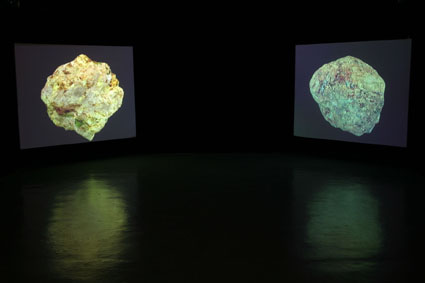
Anthony Gross, From Here to Eternity II, Computer animation installation, UK, 2002 – present
-+-(negative plus negative), is a contemplative, sometimes gently disorienting experience, a tautly curated exhibition (Gridthiya Gaweewong), modest in scale but richly suggestive, comprising works by Thai and Thailand-based British artists. It quietly embraces the domestic–a trio of large Bangkok family portraits vibrate in “the 'in-between' space of photography and animation”; the urban–a 3-screen “healing space [offers] refuge from the pressures of everyday life”; the political–roped monitors loop tense border crossing images; the cosmic–3D animated meteorites tumble and disintegrate; and the metaphysical–a projected, rotating mandala critiques the foolishness that brings on economic crises.
The sense of in-betweenness is pervasive in -+-(negative plus negative), sometimes triggering the curious dialectic suggested by the title, sometimes evoking suspension (and MAAP's gravity theme) both literally and metaphorically, and generating a reflective unease, a reminder that borders are not just lines to be crossed but states where being is denied or can evaporate.
In Wit Pinkanchanapan's Family Portrait (2002; see Virginia Baxter, “The pause that refreshes”) the father hoses his hand in the garden. It's a still-life video with a little movement, a kind of involuntary vibration of body and globules of suspended water. There's an odd sense of vulnerability. In the next portrait, in a moment of control and anticipation, the mother in traditional dress holds up a treat for 3 large, eager dogs as high as her waist. The third portrait is of a young woman in a domestic storeroom holding a large blue plastic box labelled “PA Supply.” The only subject to look at the camera, she smiles, moving the box ever so slightly up and down, suggesting both the weight of the task and her strength. Apparently she is not 'family.' The son is the portraitist. This woman is a maid, presumably with all the connotations of that role in South-East Asia in terms of labour, migration and exploitation, and the status of the servant as part of the family, or not. The vibration of minimal and repeated action in this trio of images reads like a capture for a time capsule, a quivering trace of middle class Thai life in the early 21st century.
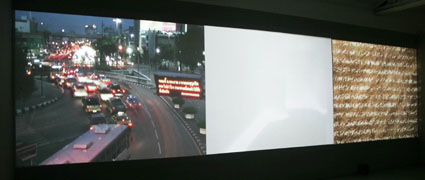
Kamol Phaosavasdi, Techno Temple, Video Installation, Thailand, 2004
Kamol Phaosavasdi's Techno Temple is also an experience of stasis and movement, but here the dynamic is of sustained stillness and sweeping flow rather than the minutiae of vibration. The image on the central screen is grey and white, flaring, still. The gallery text says it's a real time image of a room. The image to the left is of a busy intersection in the passage between light and dark, traffic moving in stop-start flows, the predictability of the rhythm exaggerated by running the camera slow so that the patterning is accelerated. Rather than the image inducing infamous Bangkok traffic anxiety, its effect is painterly and calming. The vehicles gather before the stoplights, neat and still before rushing away, merging and dissolving into long brush-like streaks of colour, a river of abstracted traffic, and from the other direction comes a transcendent flood of headlights. The accompanying sound score, among other things, is of the flow of water, a chorus of birds and perhaps temple chanting and bells in an otherworldly sonic constellation. Techno Temple is just like the refuge offered by real temples in the midst of busy Asian cities, where noise seems to be backgrounded or banished. The third screen displays a sandy surface over which screen-deep layers of words scroll left to right, rippling in and out of view as they pass over slight ridges. No explanation of their meaning is at hand, but their constant, gentle flow suggests again meditative reflection as part of a cumulative, 3-screen image of urban life, language and domestic space viewed from an easeful distance and transformed into ethereal forms.
In a long, darkened space, 2 meteorites in From Here to Eternity II, by British artist Anthony Gross, appear one at a time on separate screens angled slightly towards each other. As one meteorite forms suddenly from a small cluster of tiny stars and rolls through space, the other on the second screen becomes transparent, flares with colour and explodes, and the cycle starts up again. In each appearance the shape of the large meteorite is the same, but it is the colour and texture of the surface which fascinates as it changes cycle to cycle, from a crusty white, to grey, to orange flecked with reds, looking sometimes precious, sometimes hot, snakeskin-like, sometimes stark, icy and threatening. The 'Eternity' evoked here is of endless creation and destruction, a sameness relieved by the beauties of the transformations allowed by colour and form. From Here to Eternity is a novel (and subsequently a famous film) by James Jones about tensions of race, class and sex within the American forces in World War II. Gross' vision offers no narrative and no such specificity, just a series of not big but small beautiful bangs. The overarching rhythm of the turning meteorites punctuated by explosions and the dance of stars prior to re-creation places us again in the in-between, in a visual mantra of the acceptance of cycle and change.
In the 16-minute video loop installation A Song for No Man, Jim Prevett & McArthur (the aggregate name of just one artist) hangs one video monitor from the ceiling with thick rope, tying it to another placed facing it on a chair. On the hung monitor a man hangs in space, we see him from the waist down, jerking about, the result of editing but uncomfortably like watching a hanging. He is suspended over a road that leads to a border control station. People cross the border on a sunny day, officers go about their tasks, while the hanged man is ignored, stuck in-between, between nation states, between life and death. On the second monitor, people wait in transit in what looks like an airport customs control section. A veiled woman stands by her luggage trolleys interminably waiting, but suddenly 2 men wheel them away for her. The soundtrack grumbles with slowed down voices, the dark murmur of authority. Here people seem to pass through the in-between of borders, but slowly. The light of one image, the darkness of the other, the tortuous fixity of the first and the underworld gloom but fluidity of the second play out a grim dynamic.
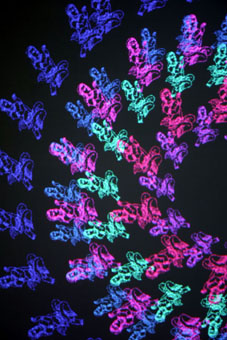
Sakarin Krue-on, Circle of Hope, Single-screen video, 5-min loop, Thailand, 2003
Sakarin Krue-on's Circle of Hope is a 5 minute video loop in which the image of Nang Gwag, the goddess of prosperity (whose image graces the entrances of many a Thai shopfront) is multiplied many times over in low definition, forming a large rotating circle within which concentric circles multiply, expand and contract, pushing the largest circle out, the whole pulsing with ever-changing lurid colours–pinks, blues, greens, yellows in many permutations against a black background. This mobile mandala is like a giant transparent jellyfish, rippling with colour, swelling and compacting as it moves through deep dark waters. And perhaps it's as toxic as a jellyfish: the gallery text says that the artist's target is the lure of prosperity that creates national economic crises. Seductively beautiful in itself, Circle of Hope is an ironic, mesmeric meditation on prosperity, portraying desire as a living thing. The in-between suggested by this work resides in the disjunction between the beauty of the image and the false hope it conjures.
-+-(negative plus negative) is a satisfying and well deployed gathering of works in which border states are experienced not just as content, whether political, moral or psychological, but in vibrations, pulsing and flows, a visual musicality that links all the works in their very different evocations of in-between states.
-+-(negative plus negative), curator Gridthiya Gaweewong, Project 304, Chiangmai, Thailand; organised by Earl Lu Gallery, LASALLE-SIA College of the Arts and MAAP; MAAP in Singapore-GRAVITY, Oct 7-31
RealTime issue #77 Feb-March 2007 pg.
© Keith Gallasch; for permission to reproduce apply to realtime@realtimearts.net













 Feng Mengbo, The Invisible Words: A GPS Calligraphy Project, 2006,
Feng Mengbo, The Invisible Words: A GPS Calligraphy Project, 2006,











 Lantern of Fear, Gulielmo Jacobo ’s Gravesande,
Lantern of Fear, Gulielmo Jacobo ’s Gravesande,







